Israel Museum, Jerusalem – Visitors Guide
The Israel Museum, Israel’s national museum, includes an archaeology wing, a Jewish Art and Life exhibition, the Dead Sea Scrolls, and more.
Note: see 15 Best Museums in Jerusalem for additional information about museums.
Table of Contents
Opening Hours
Sunday, Wednesday: Closed
Monday, Thursday: 10:00 – 16:00
Tuesday: 16:00 – 21:00
Friday: 10:00 – 14:00
Saturday: 10:00 – 16:00
Entrance Fee
Adult: 62 NIS.
Child (5 – 17 years old): 31 NIS (free entrance for kids on Tuesday and Saturday).
Student: 45 NIS.
You purchase tickets on the official site or at the cash register at the entrance.
The entrance ticket price includes an audio guide (available in different languages). You can also download an audio guide app. There are free guided tours occasionally, but we will get to them a little later.
Note: opening hours and ticket prices were updated in November 2024. In any case, recheck the official site before visiting.
Coupons
Here is the list of currently available coupons:
- Max credit card – starting from 39 NIS per person.
- Cal credit card – 39 NIS per adult and 22 NIS per child.
- Pais – 39 NIS per adult and 25 NIS per child.
- HTZone – starting from 15 NIS per person.
- Mega – 37 NIS per adult and 23 NIS per child.
Guided Tours
The museum offers a range of guided tours. Most, if not all, are free to join. You need to be in the right place at the right time. You can ask for additional guidance at the entrance.
There are usually two types of tours: tours dedicated to a specific wing and highlights tours. The tours are in various languages, including Hebrew, English, Spanish, French, and Russian. To see the updated timetable, visit the official site.
Map
Israel Museum is located at Derech Ruppin 11, Jerusalem.
Directions for drivers: Link to Waze and Link to Google Maps
Directions for public transport: Link to Moovit
Interactive map of the area:
Israel Museum is the biggest museum in Israel. According to the list of largest museums in the world (by floor area), it is in fifteenth place. You can easily spend a whole day there. Here is the plan for the complex:
The entrance is in the bottom left corner (next to the arrow and #1). Then, you can see the galleries (orange, blue, turquoise, and purple). In the bottom part, you can see the park with sculptures, the Shrine of the Book (#16 and #17), and the Second Temple Model (#19).
Parking
There is a free parking lot by the museum’s entrance. You will find a spot if you arrive during the first half hour after the museum opens. However, during one of our visits, we arrived later in the day, and it was full. We had to park near the museum’s rear entrance (Nakhman Avigad and Avraham Granot Streets). That added a 10-15-minute walk.
Events
The museum offers family activities, special events, gallery talks, and more. Most are in Hebrew and English and cost extra. The updated event list is here.
Exhibitions
This section will review the exhibitions we saw on one of our visits.
A Brief History Of Humankind
The first temporary exhibition we saw in the Israel Museum was “A Brief History of Humankind.”
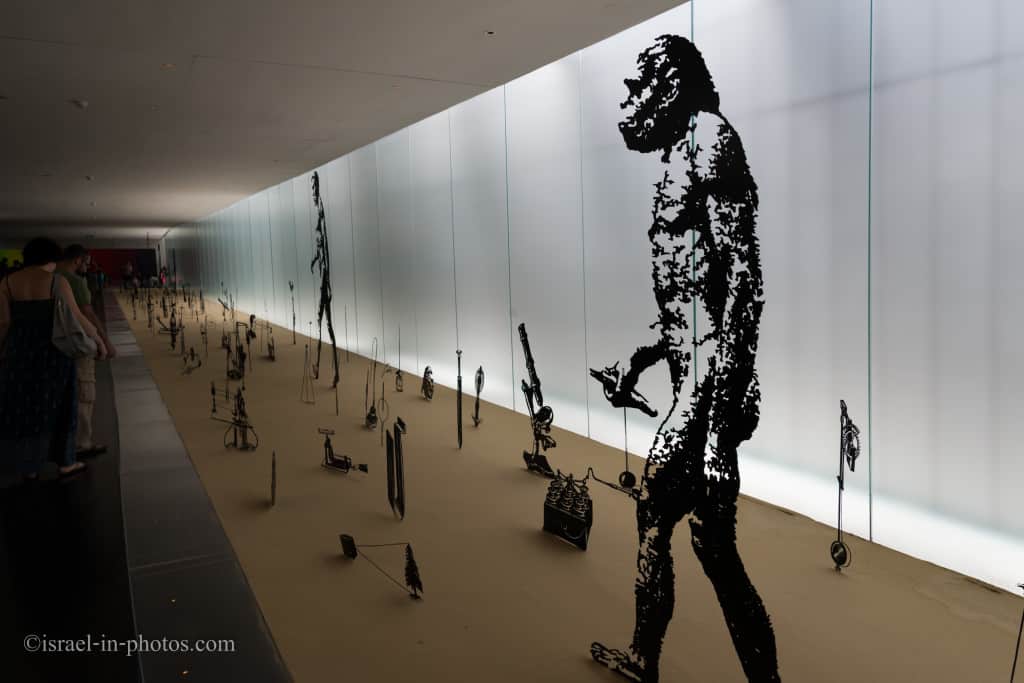
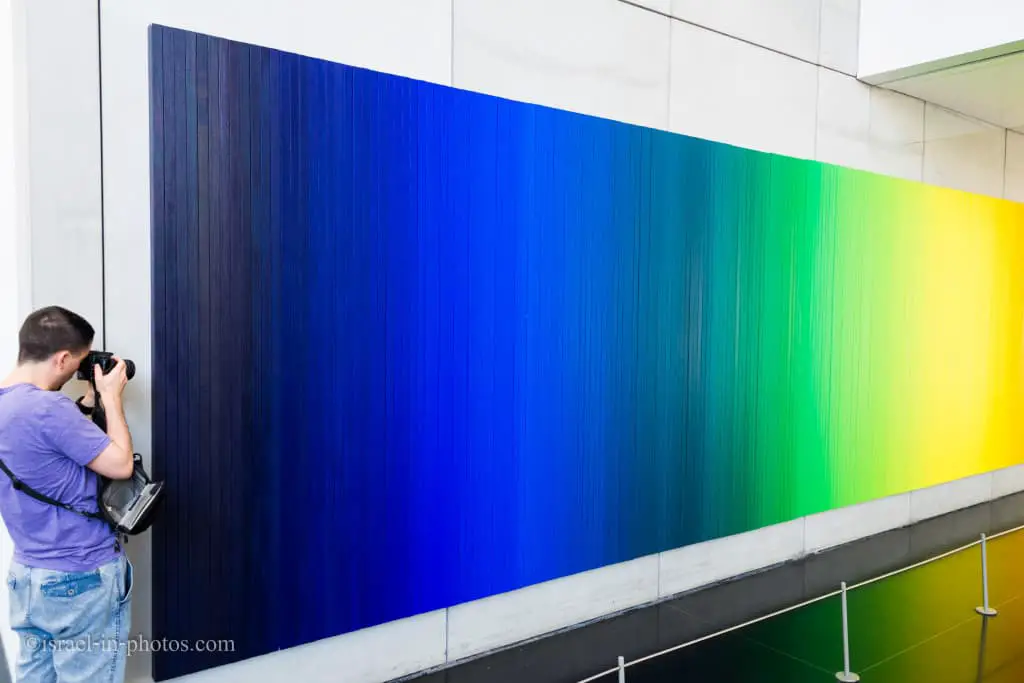
Here is what they say about it on the official site:
This exhibition, inspired by Yuval Noah Harari’s bestseller Sapiens: A Brief History of Humankind, invites the public to a journey exploring some of the crucial moments in the history of humankind through pivotal objects from the Museum’s encyclopedic collections. Spanning a timeline of hundreds of thousands of years, the items on view include archaeological objects dating to the dawn of civilization shown side-by-side with cutting-edge works of contemporary art.
The exhibition’s narrative, articulated as three major chapters, revolves around three significant turning points in the evolution of human civilization. The Cognitive Revolution — the advent of language and communication, which enabled Homo sapiens to survive and form complex societies. The Agricultural Revolution — humanity’s first steps towards the evolution of settled civilization, laying the foundations for modern society. And the Industrial Revolution — a time of rapid scientific and technological developments that ushered in the contemporary era.
“A Brief History of Humankind” discusses life and starts with fire.


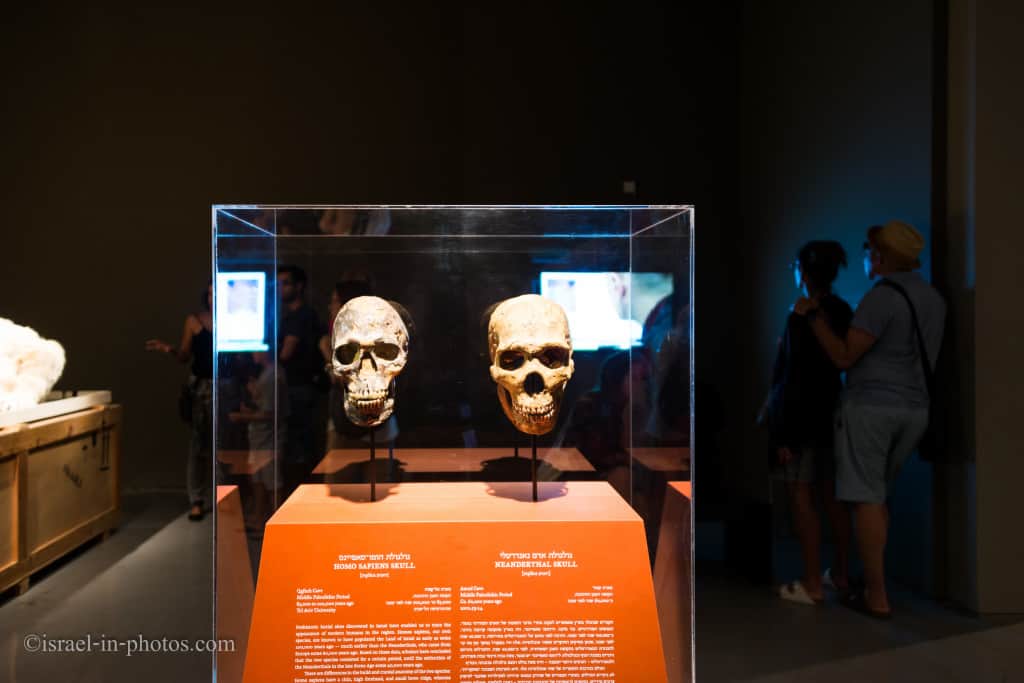
The creation of the family was a vital step in the evolution, and globalization is currently the last step.


One of the exciting items in this exhibition was Albert Einstein’s “The Special Theory of Relativity,” the original document from 1912.
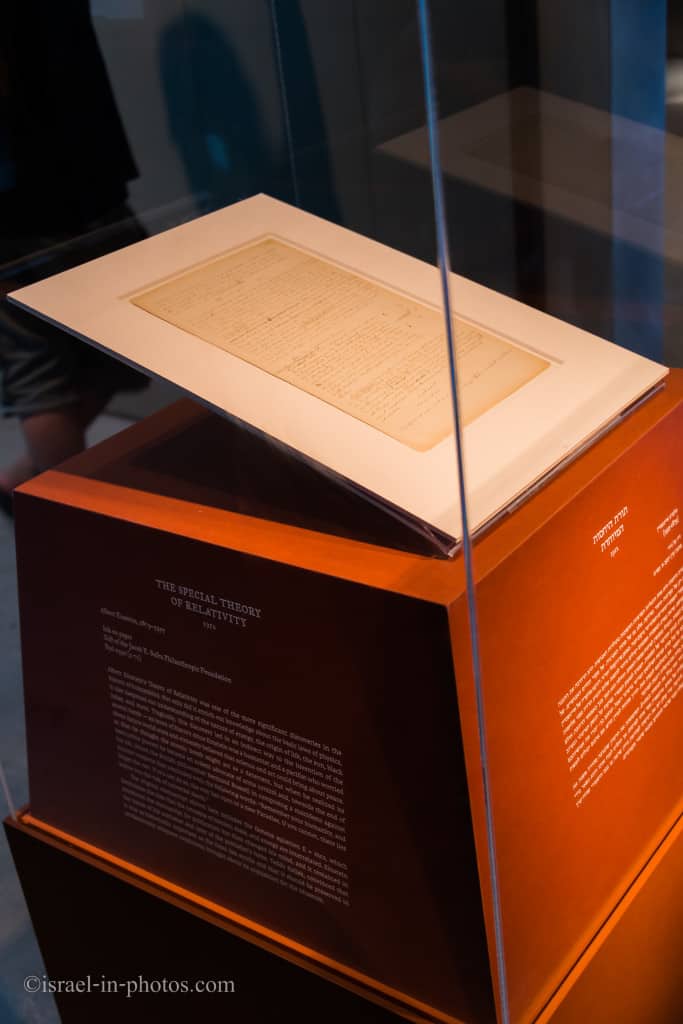

What does the future hold? Maybe this:
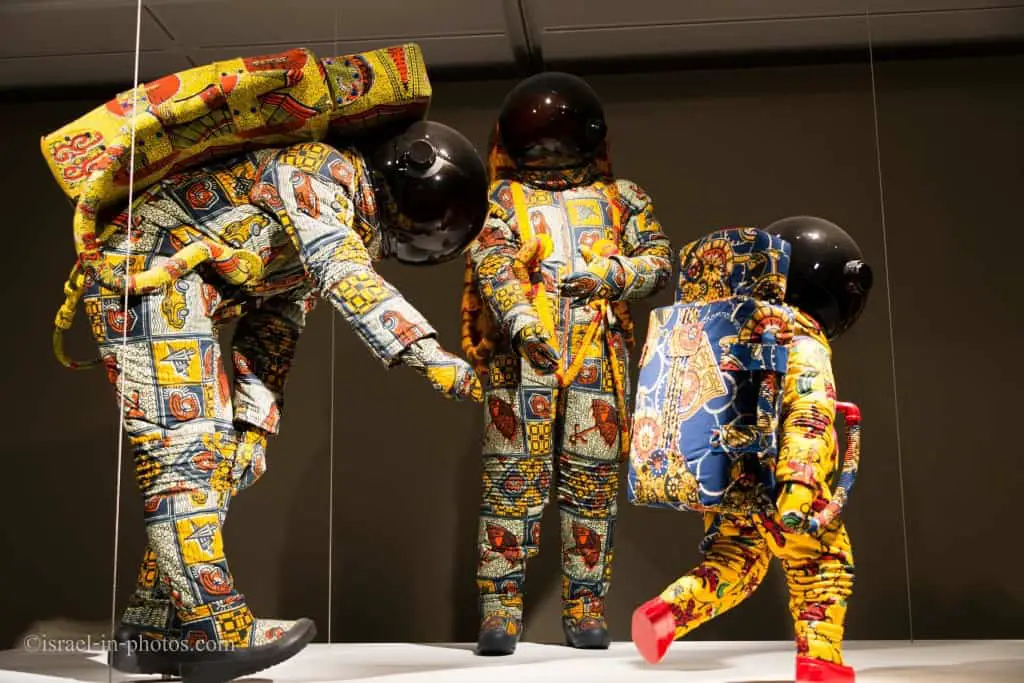
Archaeology Wing
Then we went to the archaeology wing. It is a permanent exhibition.
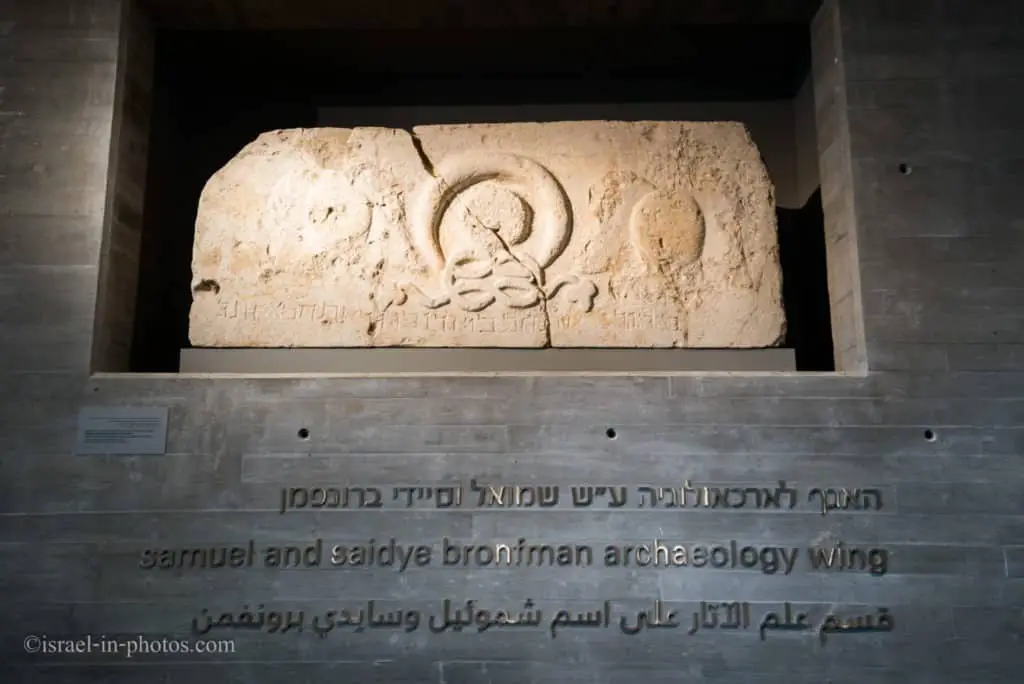
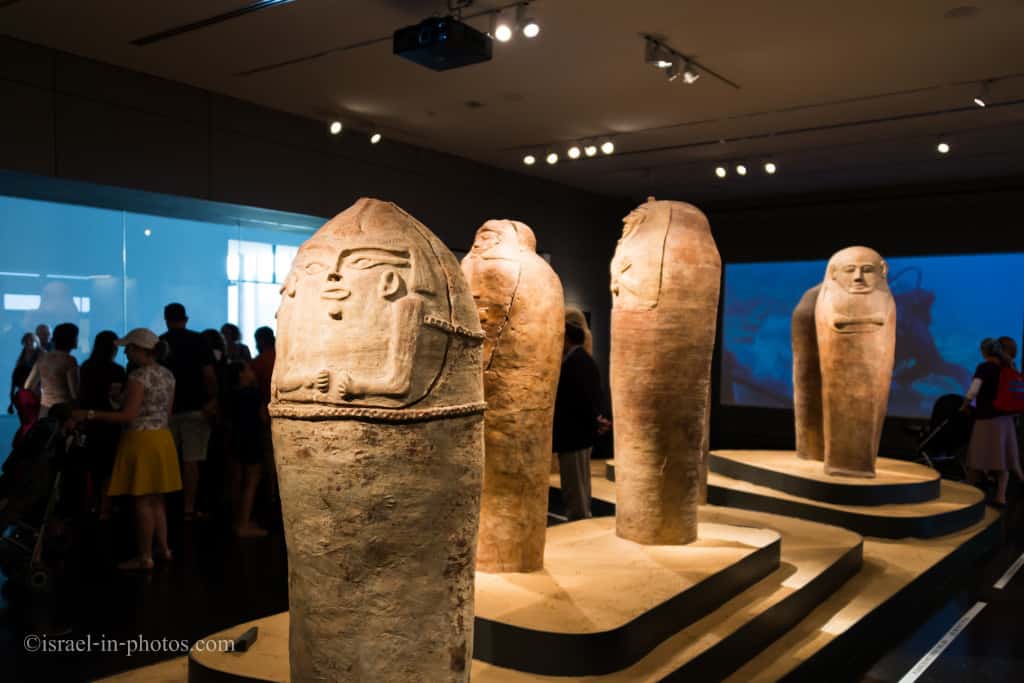
In the first hall, you can also find the Coin Treasure from Caesarea National Park:
A group of divers from the diving club in the harbor reported the find to the Antiquities Authority. Officials from Antiquities Authority then went with the divers to the location with a metal detector and uncovered almost 2,000 gold coins from the Fatimid period (11th century CE) in various denominations: dinars, half dinars, and quarter dinars, of various dimensions and weight.
Note: unless stated otherwise, all quotes were taken from the official site.
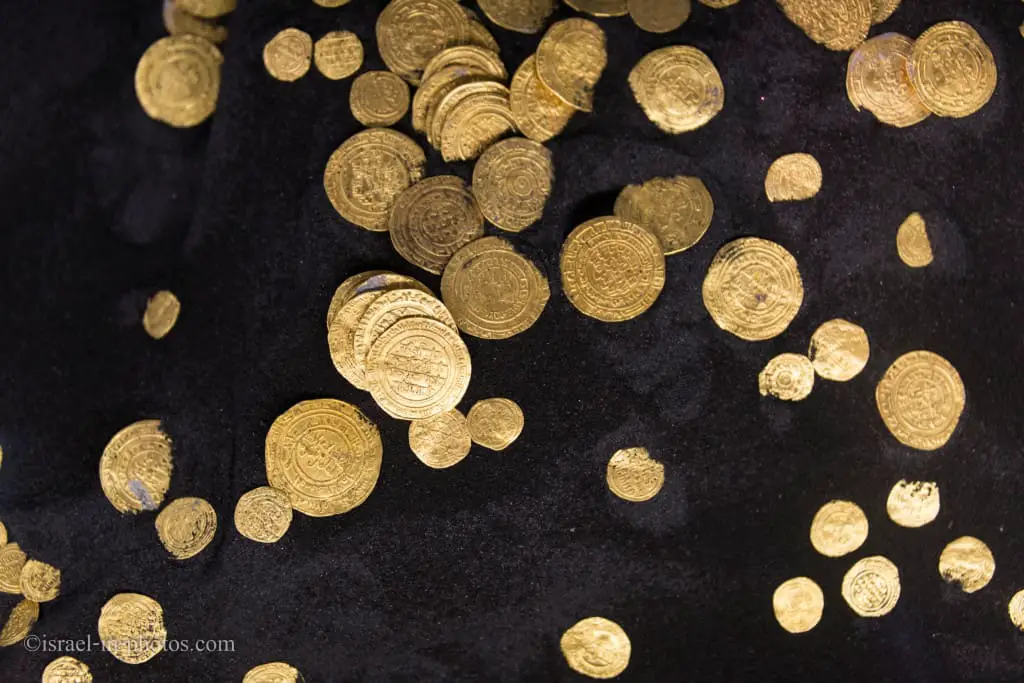
The divers found this treasure quite recently, in Feb 2015.
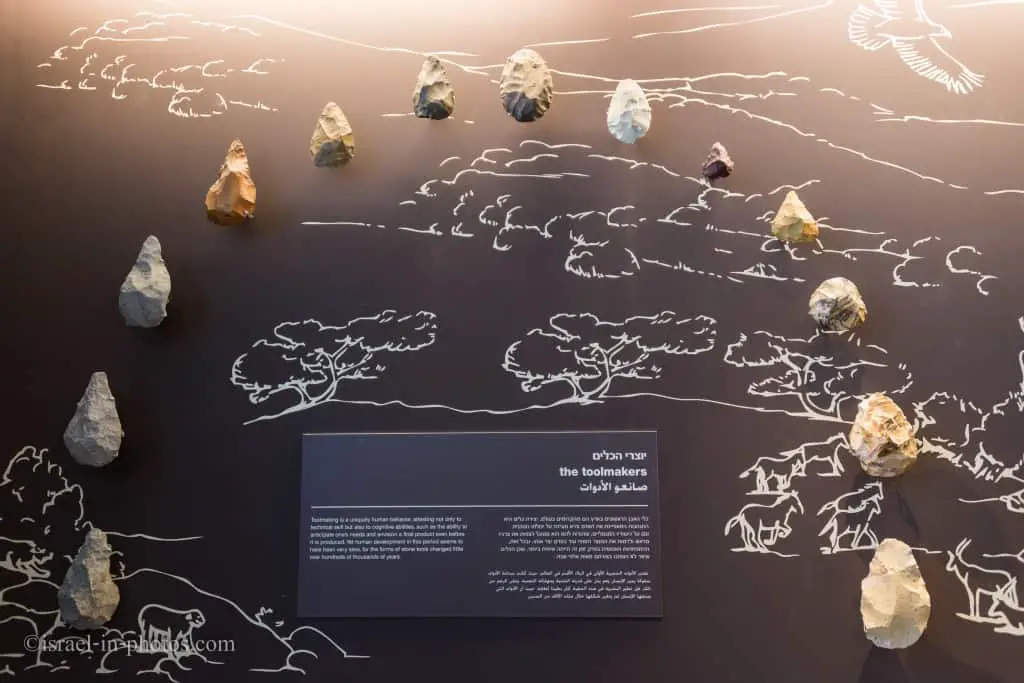
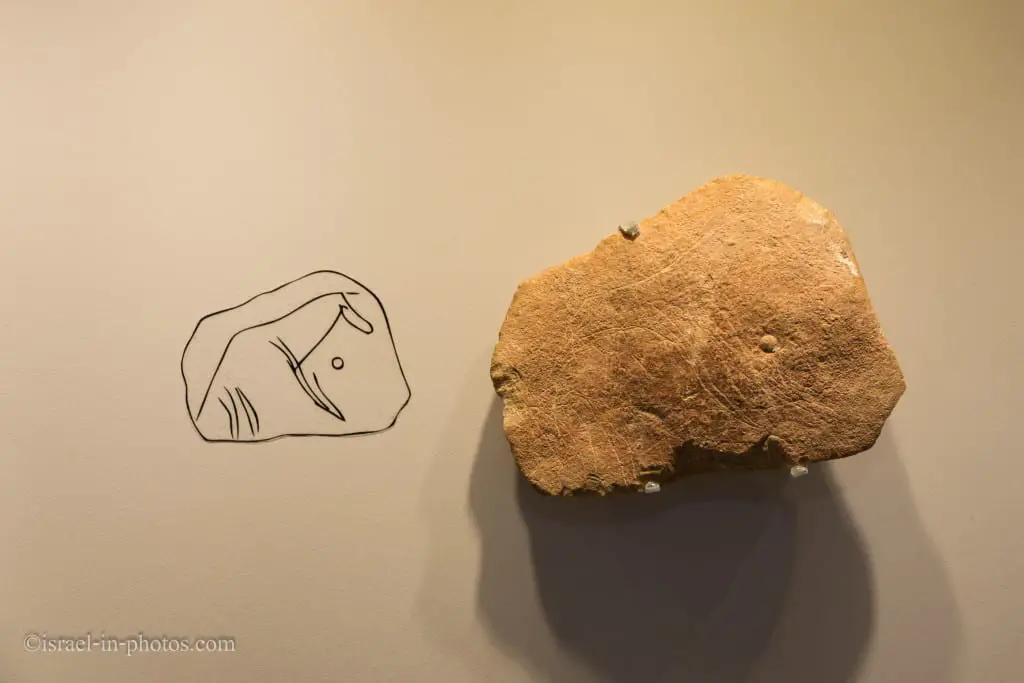


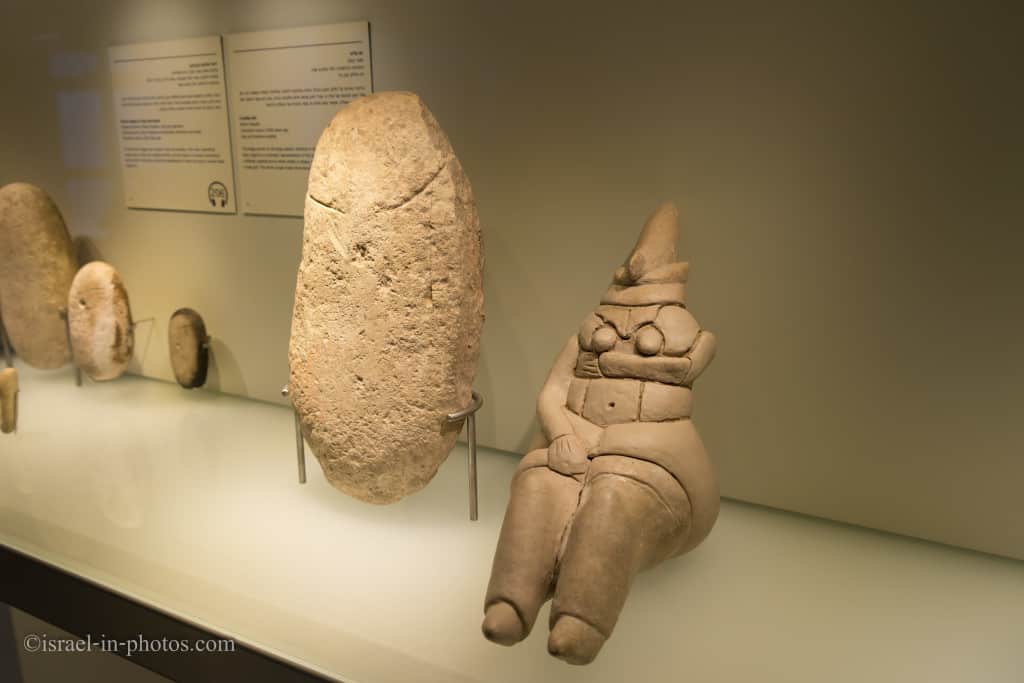
The hoard of 429 ritual objects was discovered in a remote cave in the Judean desert. It was named the Cave of the Treasure. These are some of the treasures:

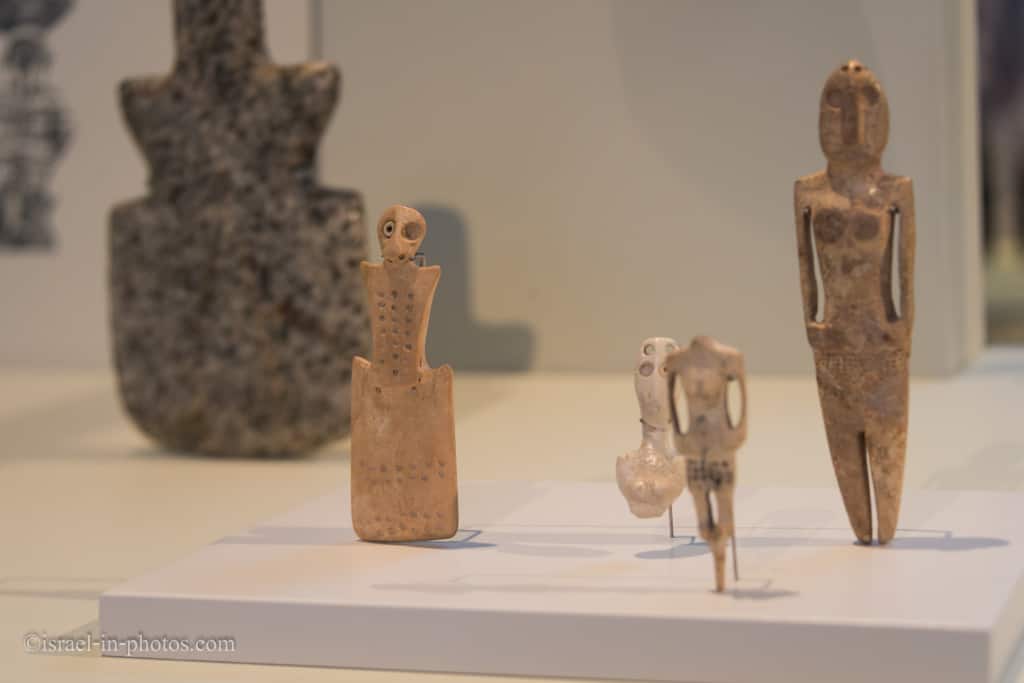
Can you guess why this pottery is hanging?
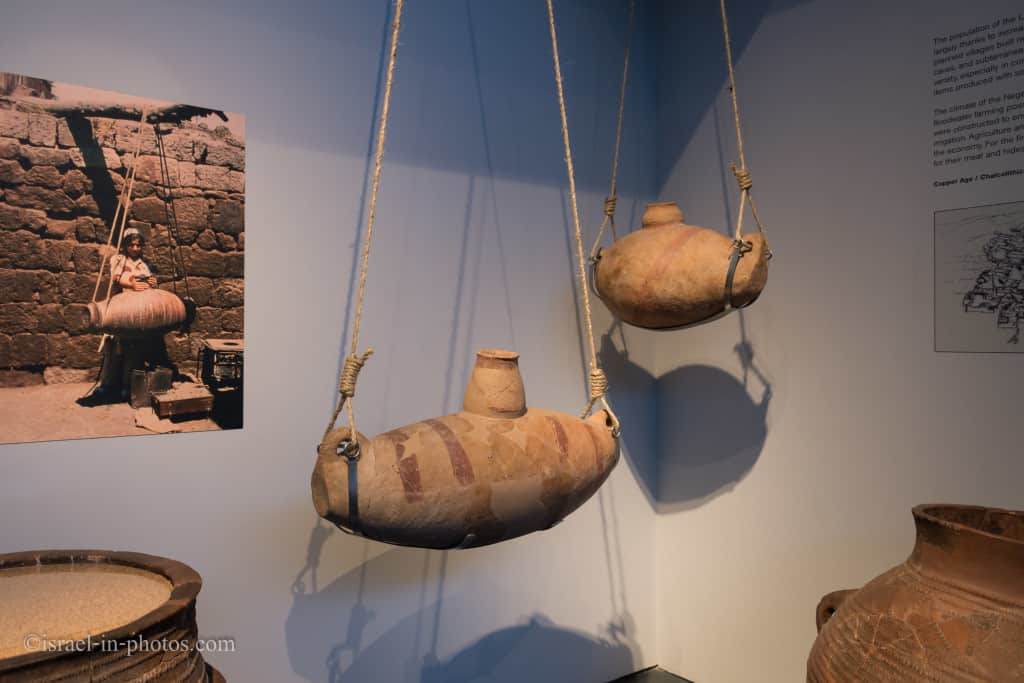
It is an old churn. Since it was hanging, it was easy to rock it from side to side. It was used to prepare butter.

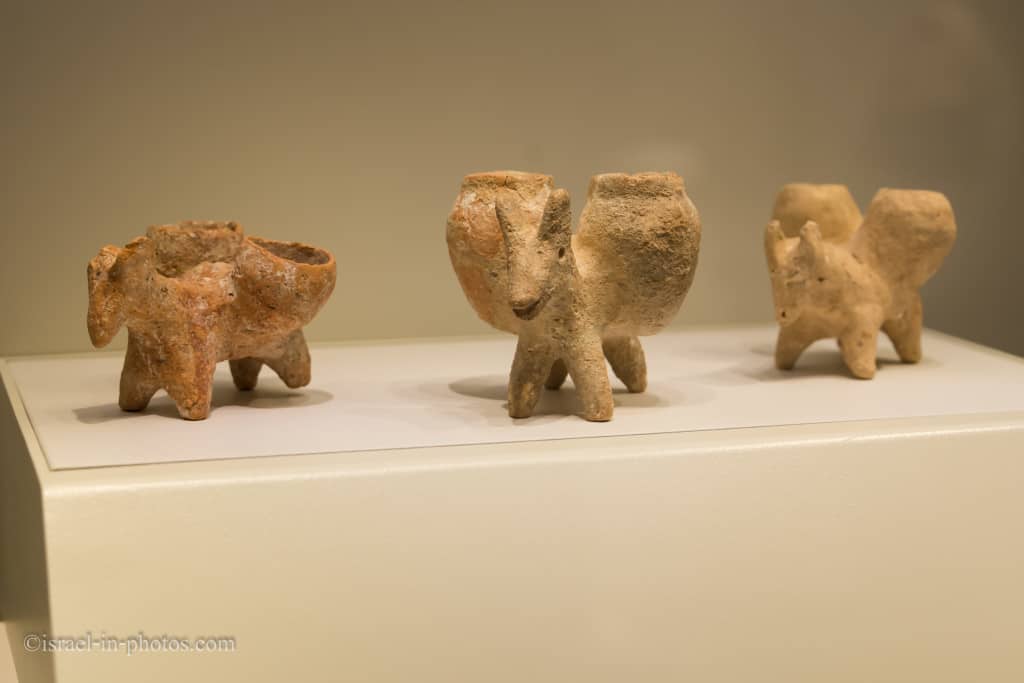
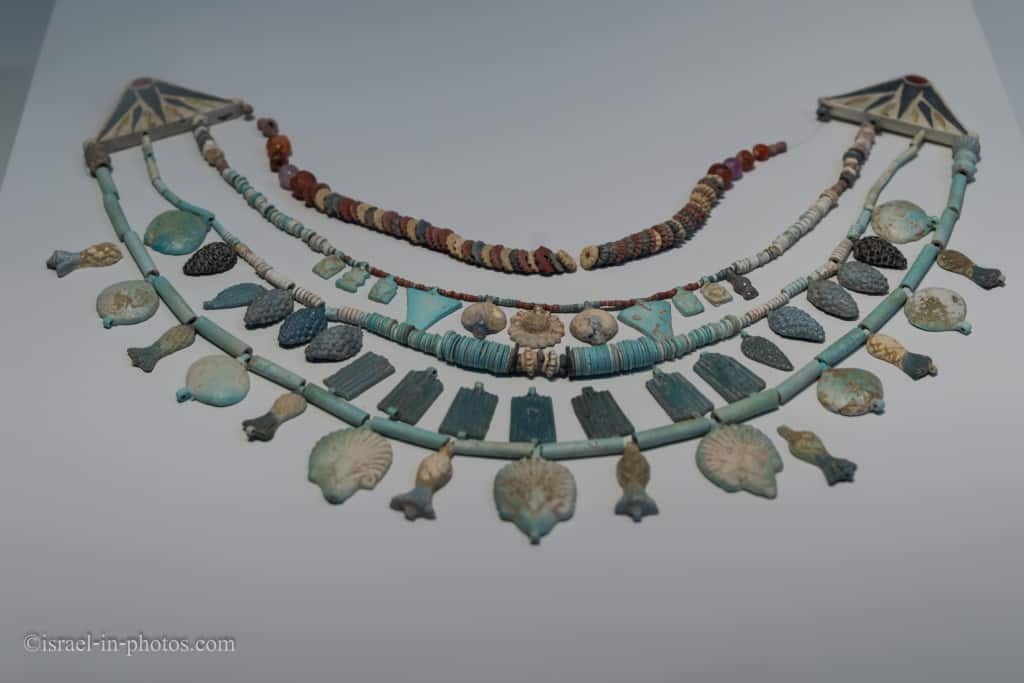


For more information about this city, check Tel Hazor.
I wonder whether this is the origin of the menorah.
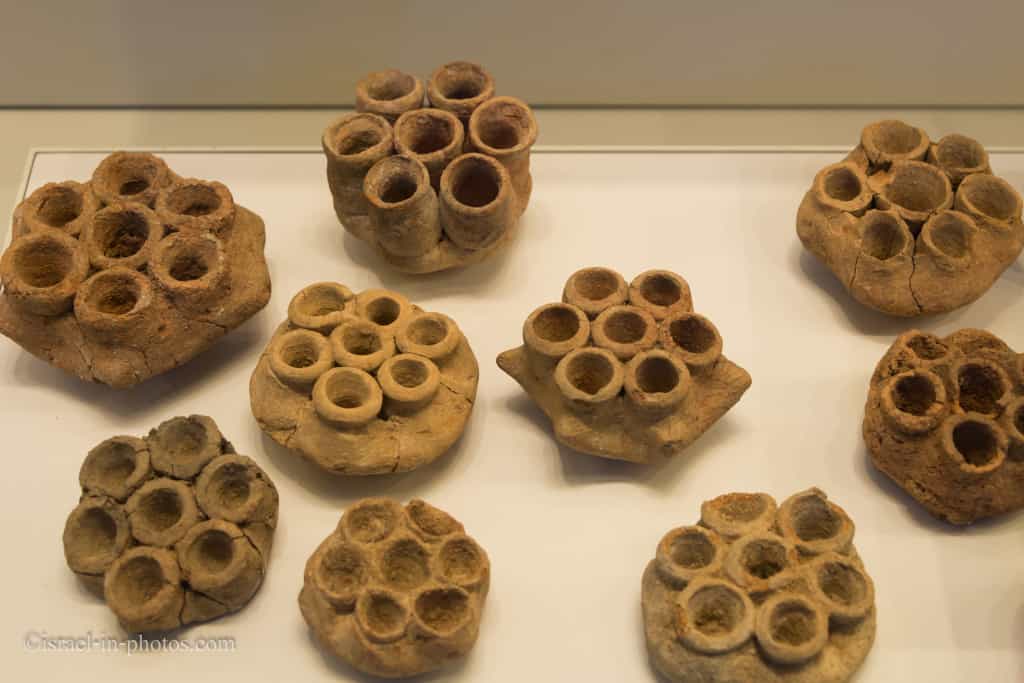
Fish-shaped vessel from Tel Poleg (Middle Canaanite period, 19th-18th century BCE):
The open-mouthed fish was a burial gift. Its face and the inside of its mouth are decorated with punctation and engraving.
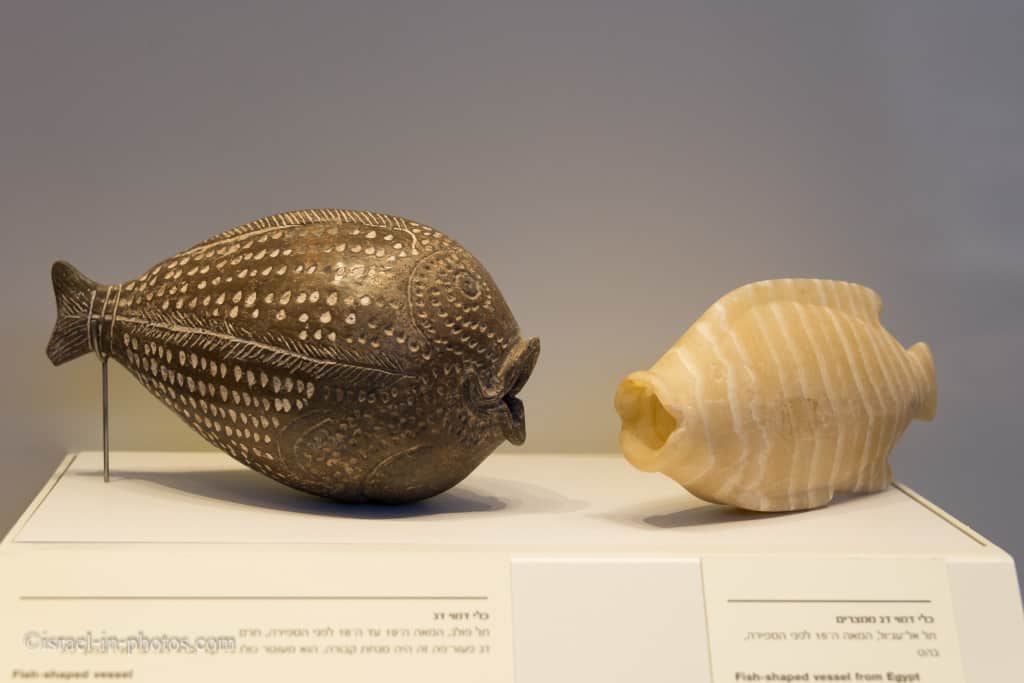
I Placed My Name There
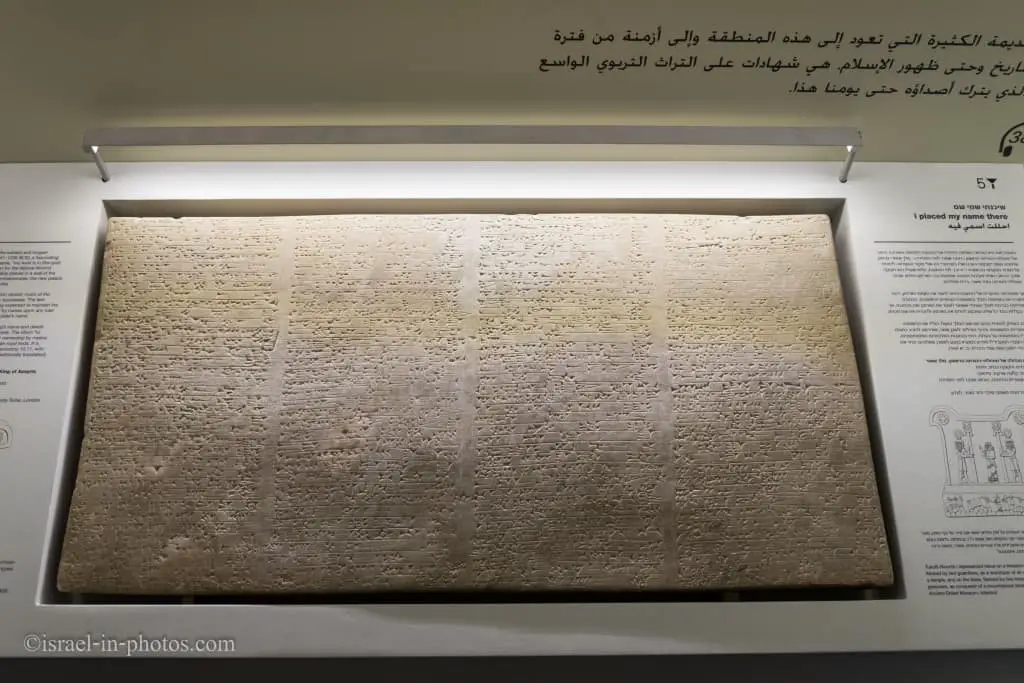
I Placed My Name There: The Great Inscription of Tukulti-Ninurta I, King of Assyria:
This is the only complete version of the earliest and longest inscription of Tukulti-Ninurta I (ca. 1241 – 1206 BCE), a fascinating Assyrian monarch whose figure and name, “my trust is in (the god) Ninurta”, may have been the inspiration for the biblical Nimrod (Genesis 10:8-12). The stele was probably placed in a wall of the building the construction of which it commemorates: the new palace that the king built in Assur, Assyria’s capital.
Despite its primary purpose as a foundation record, much of the inscription narrates the king’s first military successes. The text concludes with blessings on the future king expected to maintain the building and the inscription itself, followed by curses upon any ruler who might eradicate the building and its builder’s name.
Assyrian Wall Relief
Wall relief depicting a stylized date palm flanked by protective genies (Nimrud, Assyria; Reign of Ashurnasirpal II, 883-859 BCE):
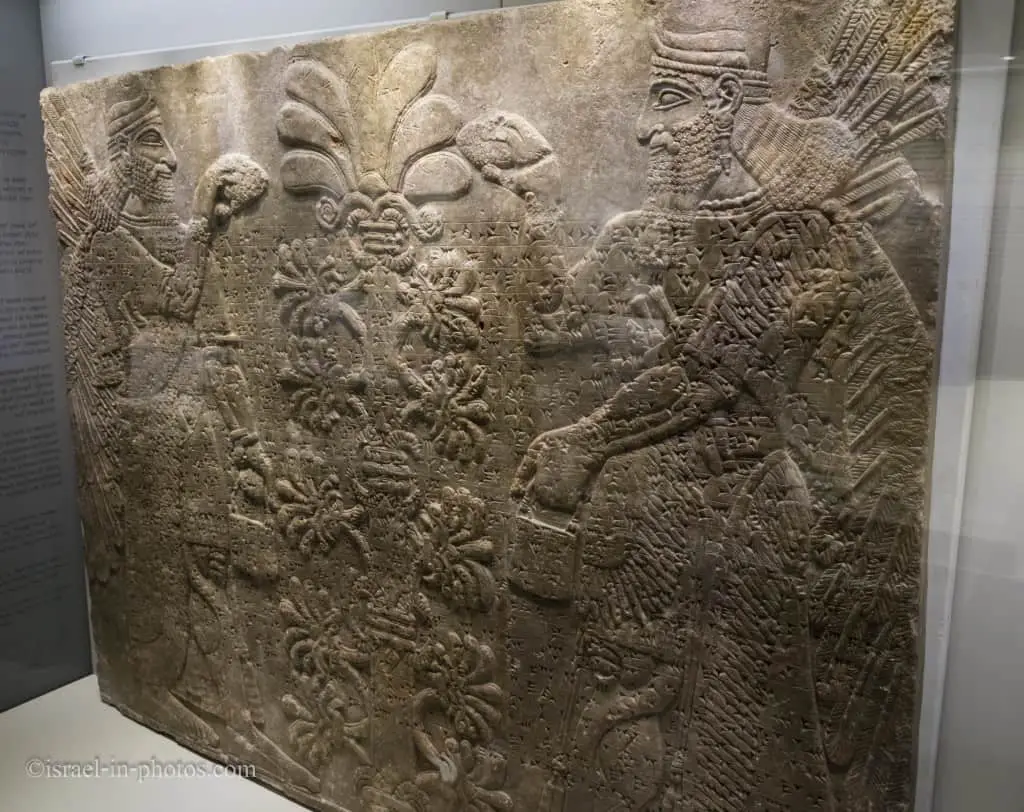
This wall relief is large (height: 157 cm, width: 203 cm, and diameter: 1.7 cm) and impressive. Here is additional info about it:
A stylized date-palm tree flanked by two winged human-headed genies appears on many wall slabs decorating the North-West Palace of King Ashurnasirpal II, built in his newly founded capital, Nimrud. The numerous repetitions of this pictorial theme throughout the royal buildings testify to the significance of the scene, despite the lack of related written sources. The motif of a tree with two genies may be a symbolic representation of the pollination of date palms, implying the bestowal of abundance on the entire kingdom.
Three aspects of this slab are of special interest: its relatively small size, its twenty-six-line cuneiform Standard Inscription (most of which tells of the territorial expansion of Assyria) stretching from shoulder to mid-calf, and its large signs. Although the exact original placement of the slab is unknown, the evidence suggests that it originated either in the east wing of the North-West Palace or the Temple of Ninurta north of it, both probably dated early in the building process of Nimrud.
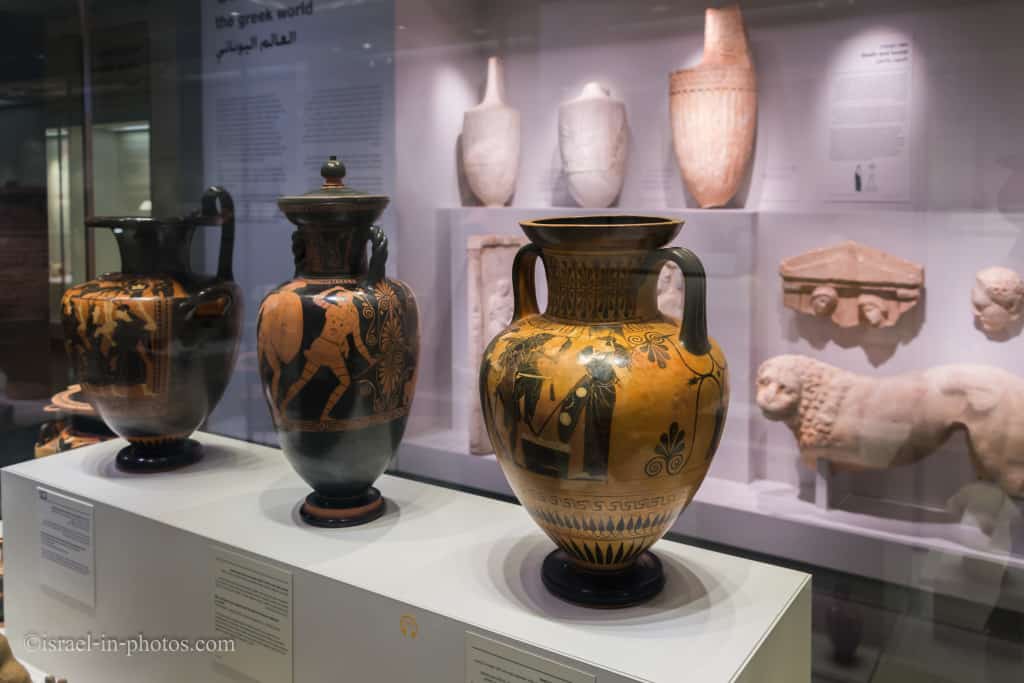
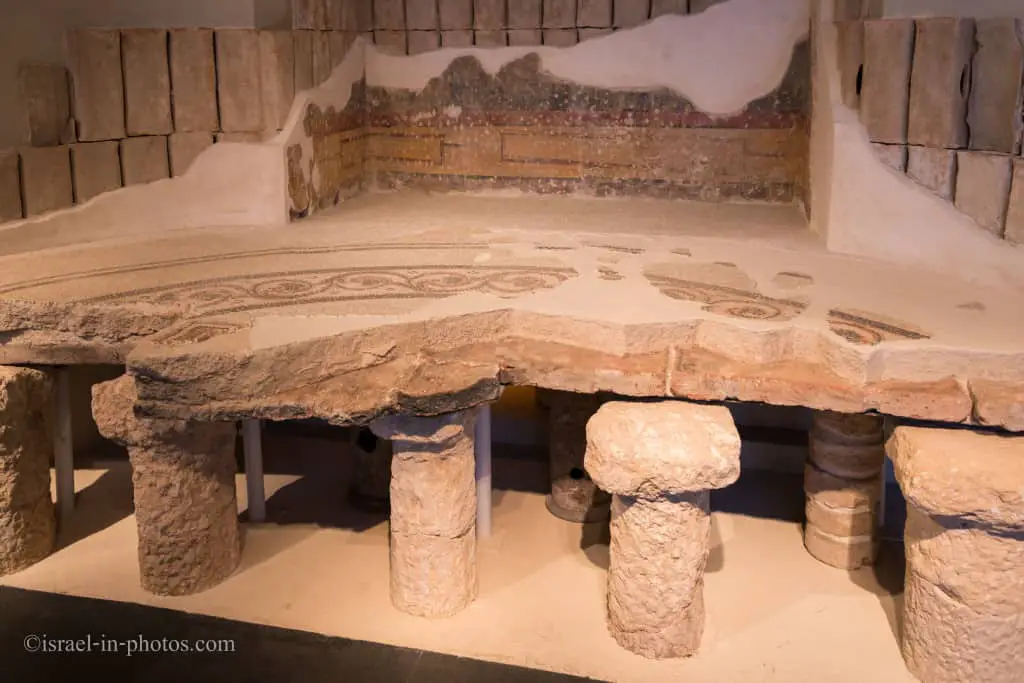
The Battle Of Lachish
The Battle of Lachish (replica):
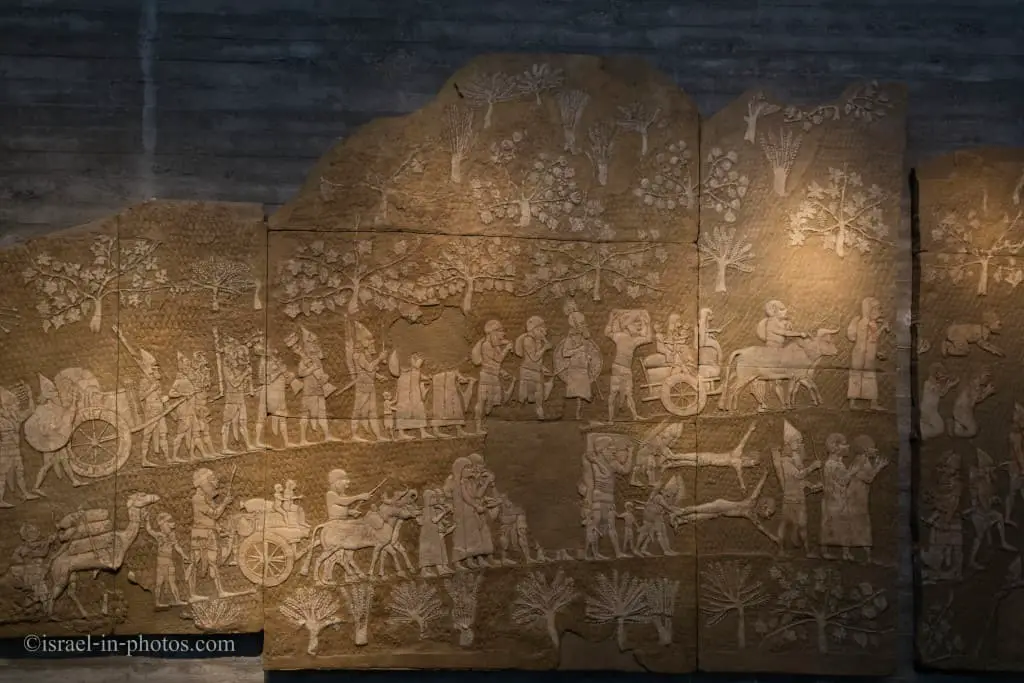
For additional info, see Tel Lachish National Park.
This relief provides a realistic depiction of the conquest of Lachish in 701 BCE. It graced the walls of an entire hall in the palace of King Sennacherib at Nineveh, underscoring the significance of this victory from the Assyrian perspective.
On the left, the Assyrian soldiers, armed from head to toe, attack the city, aided by a siege ramp and battering ram. Opposite them, the Judahite defenders stand atop the walls, raining arrows, torches, and sling stones down on their attackers. In the center, the Assyrian soldiers impale captives on poles and carry off spoils, while families of Judahite refugees head into exile, their possessions laden on carts. The right side of the relief depicts Sennacherib reviewing the procession of captives and booty. The legend reads: “Sennacherib, King of the World, King of Assyria, sat upon a Nemedu-throne and the spoil from Lachish passed in review before him.”
Original in The British Museum, London
All these ritual objects were found smashed and buried in a pit. They belong to the Edomite religion, a sign of past religious conflicts. Well, not much has changed since then.
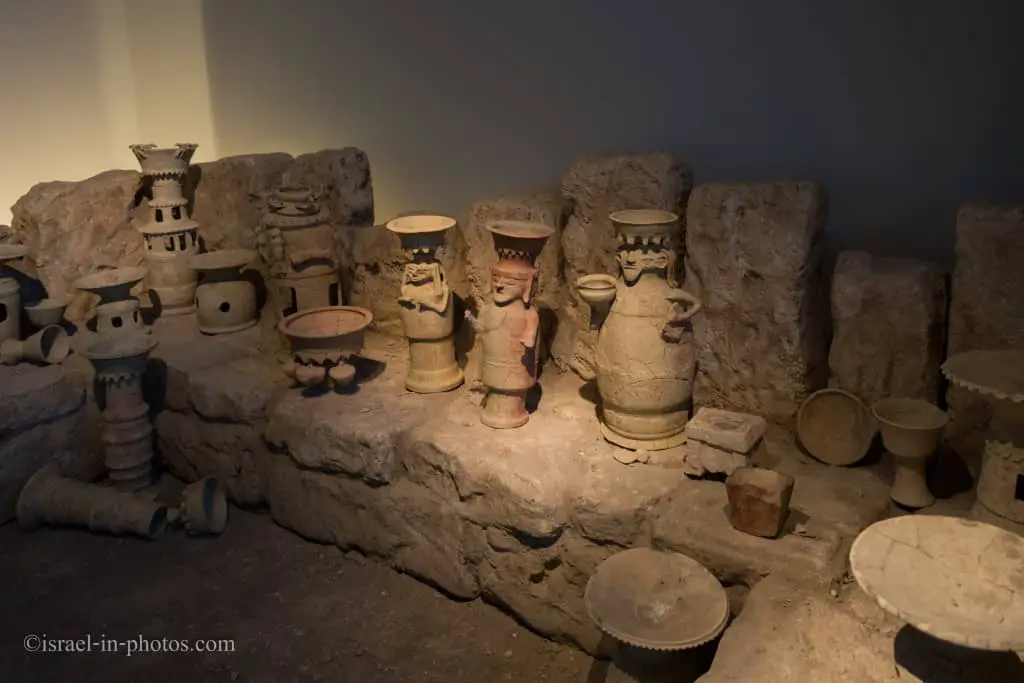
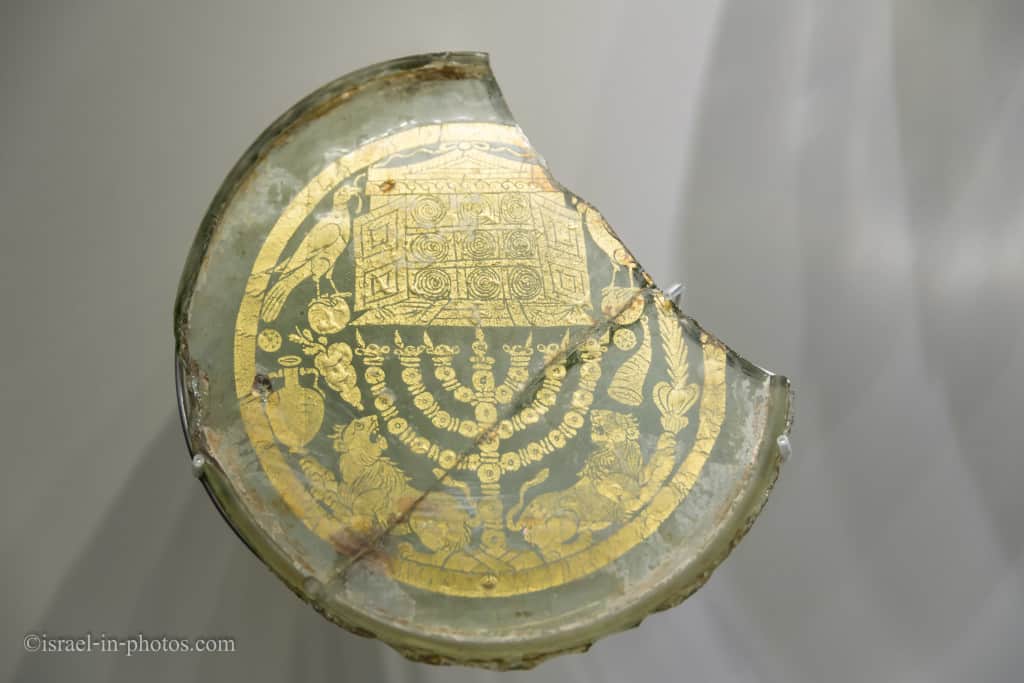
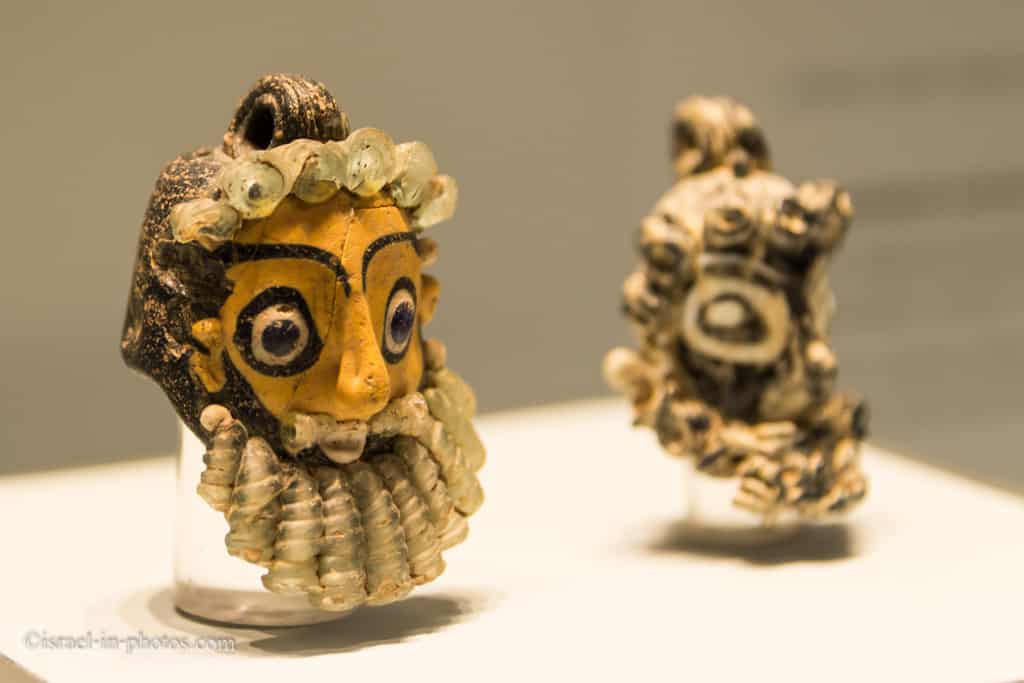
Jewish Art And Life
We finished archaeology and continued to another permanent exhibition: Wing for Jewish Art and Life. We started with Illuminating the Script, a display of rare medieval and Renaissance Hebrew manuscripts.
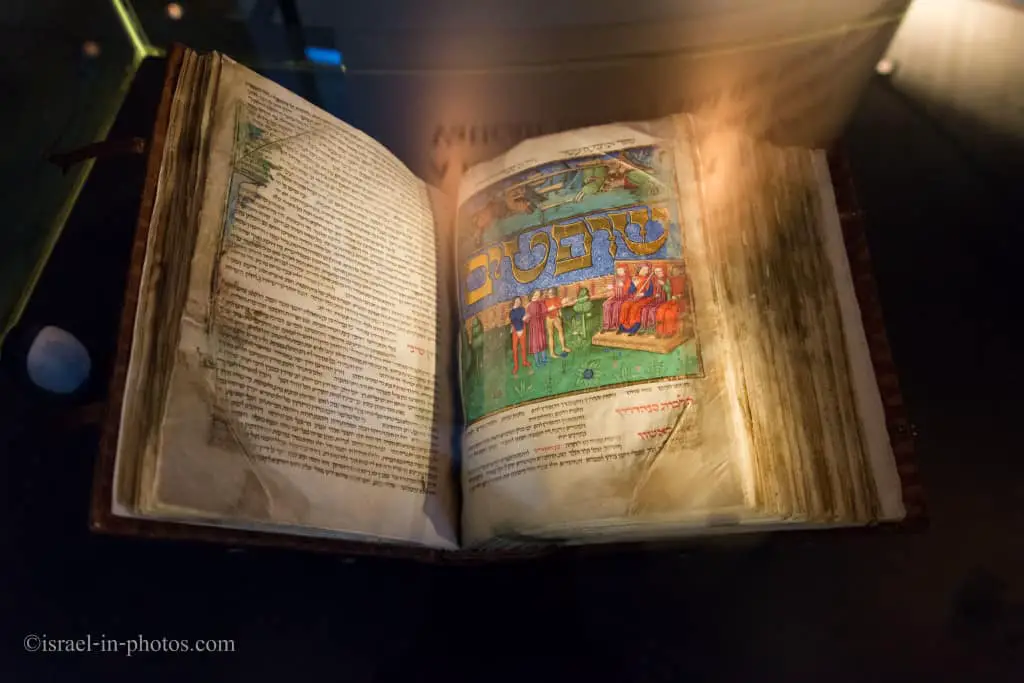
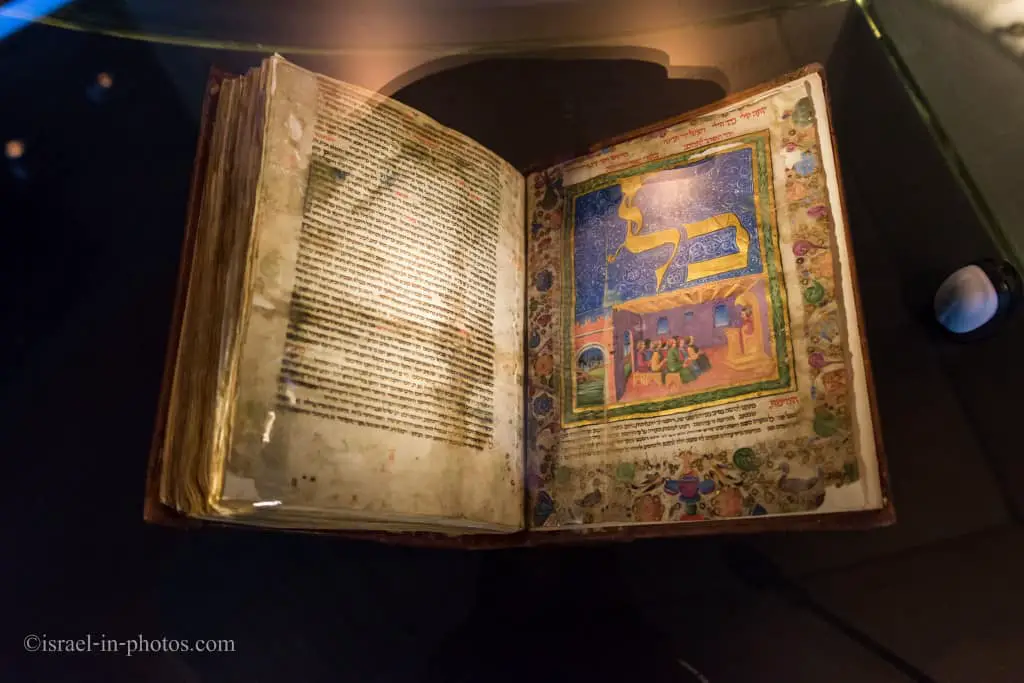
One thing that surprised me was the paintings. All these books have many colorful pictures, but the modern versions usually do not have art. Maybe it is because color was a status symbol back then (it was expensive).
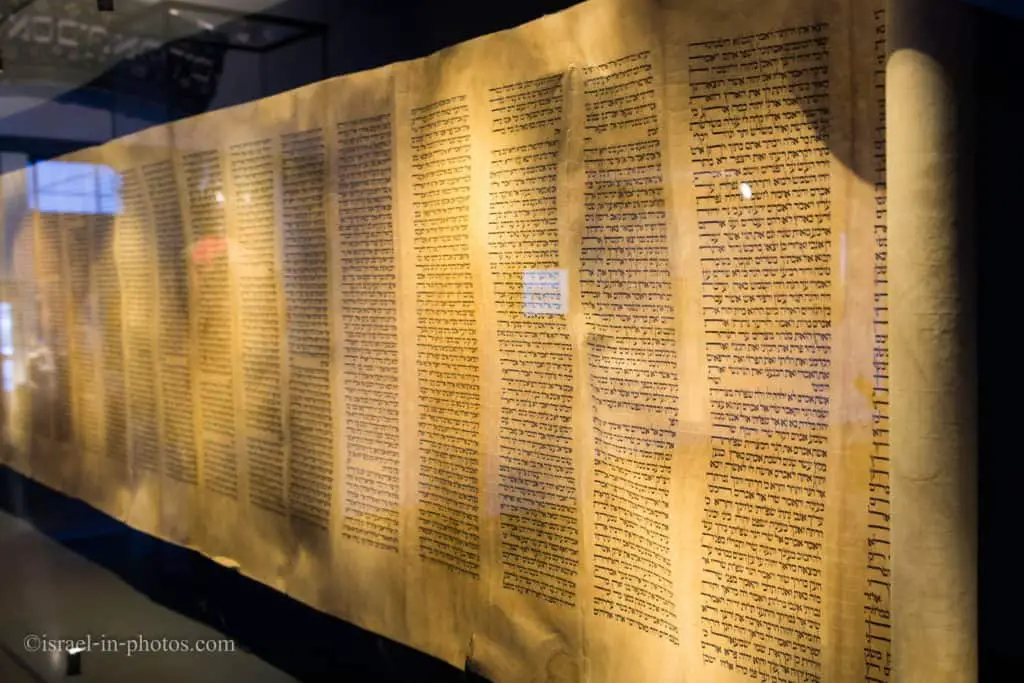
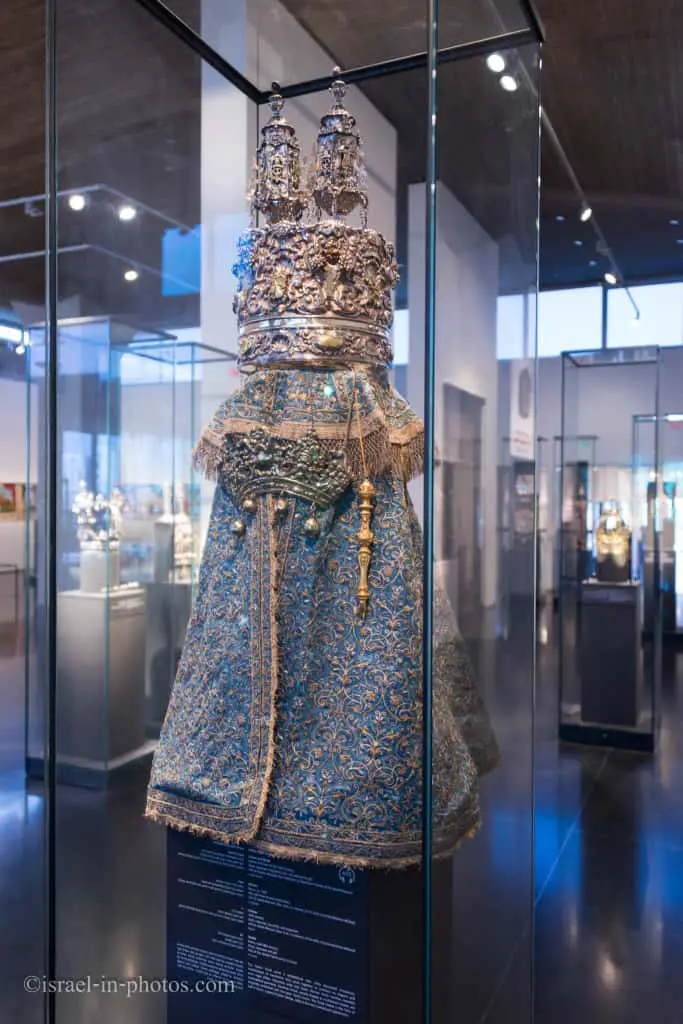
Vittorio Veneto Synagogue
Jewish Art and Life Wing also has several synagogues. The first one we visited was the Vittorio Veneto synagogue.
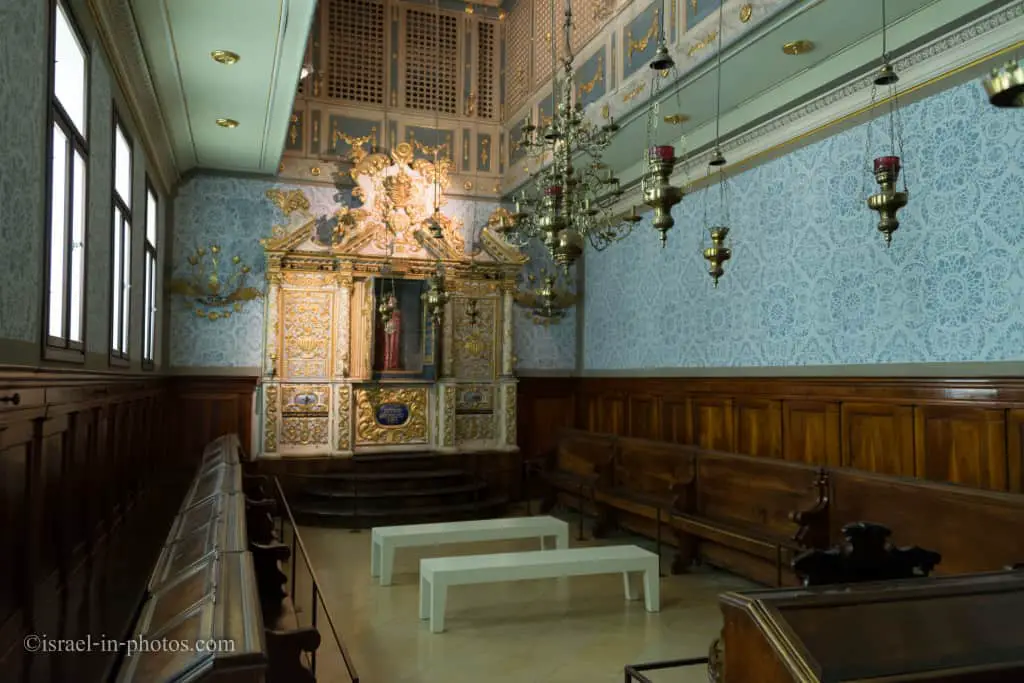
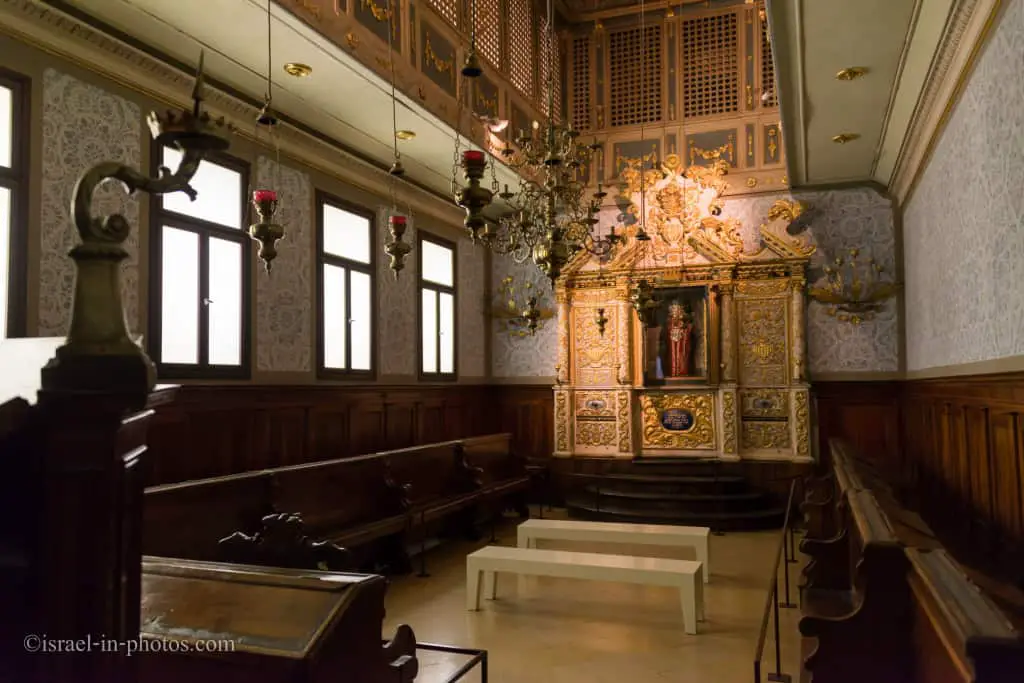
The synagogue from which this interior comes stood in the small town of Vittorio Veneto near Venice. For more than two hundred years it served a small local Ashkenazi community, which had been settled in the area since the Middle Ages. Towards the end of the 19th century, the Jews moved to larger centers, and by the end of First World War, the synagogue was no longer in use.
The original synagogue occupied the second and third stories of a simple building. This modesty was customary in Italy before the Jews were emancipated, the result of local restrictions and the Jews’ own desire to avoid drawing attention to their synagogue. The interior, however, is elegantly designed in typical Italian Baroque style, rather like a reception room in an aristocrat’s palace. Clear examples of this style are the broken pediment of the Torah ark and the shimmering surface of its carved decoration.
The interior plan is typical of Italian bipolar synagogues: they placed the reader’s desk in a niche opposite the Torah ark and benches are set along the long walls facing the center. The women’s section is located on the upper level, running along all four walls and recalling theatre galleries of the time.In 1965 the interior was transferred in its entirety to the Israel Museum, where it has been faithfully reconstructed. The only alteration has to do with the orientation of the synagogue –: because of building constraints, the Torah ark, originally on the eastern wall nearest to Jerusalem, is now part of the northern wall.
Kadavumbagam Synagogue
And this is the Kadavumbagam Synagogue:
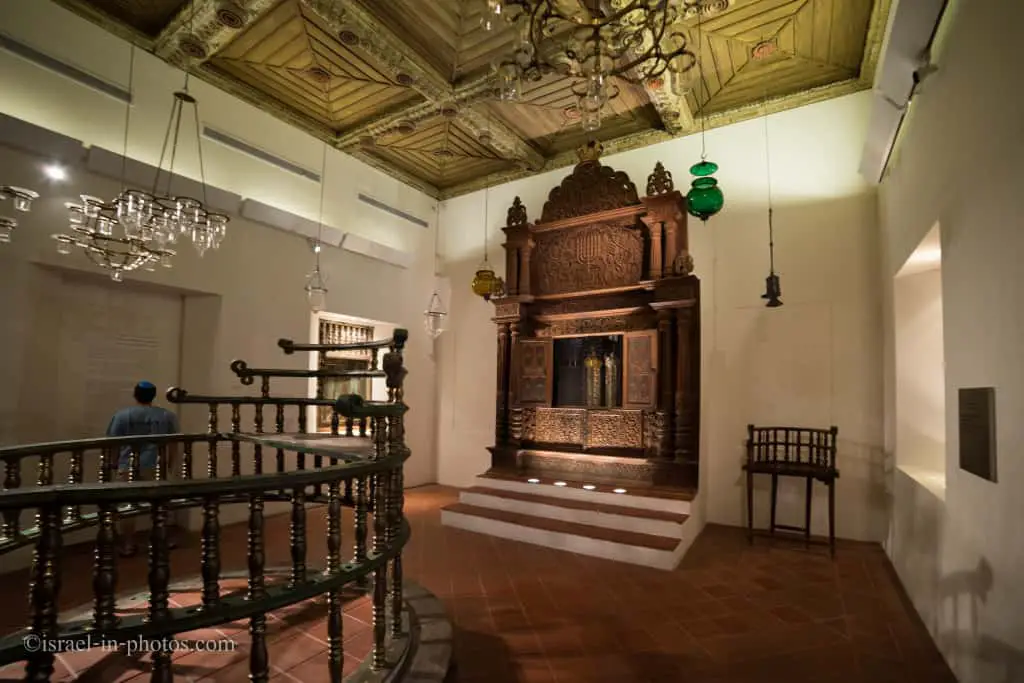
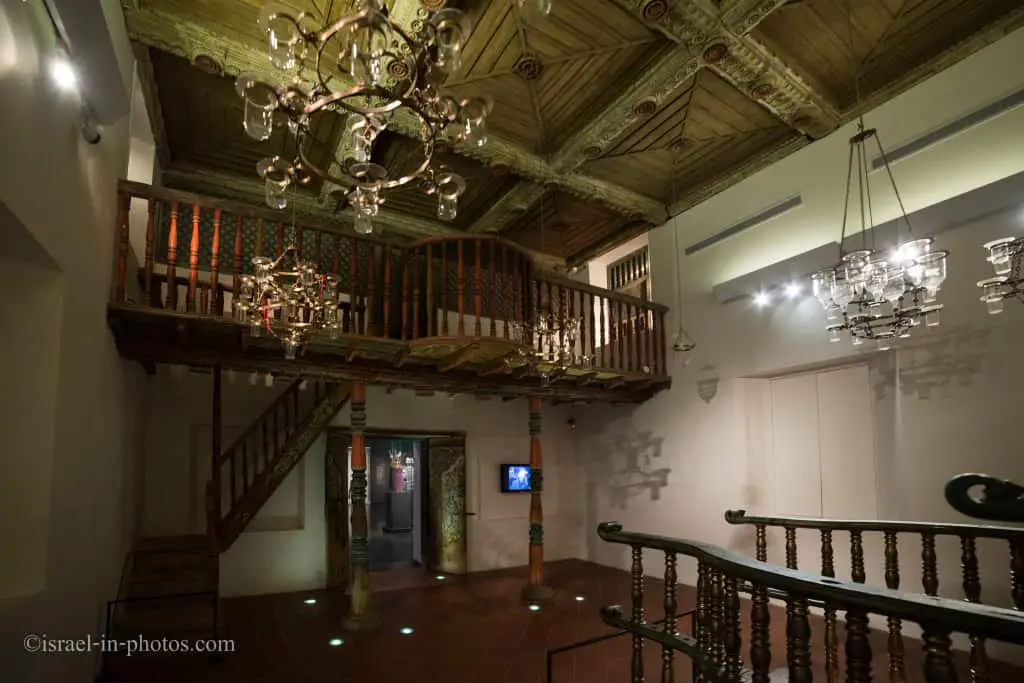
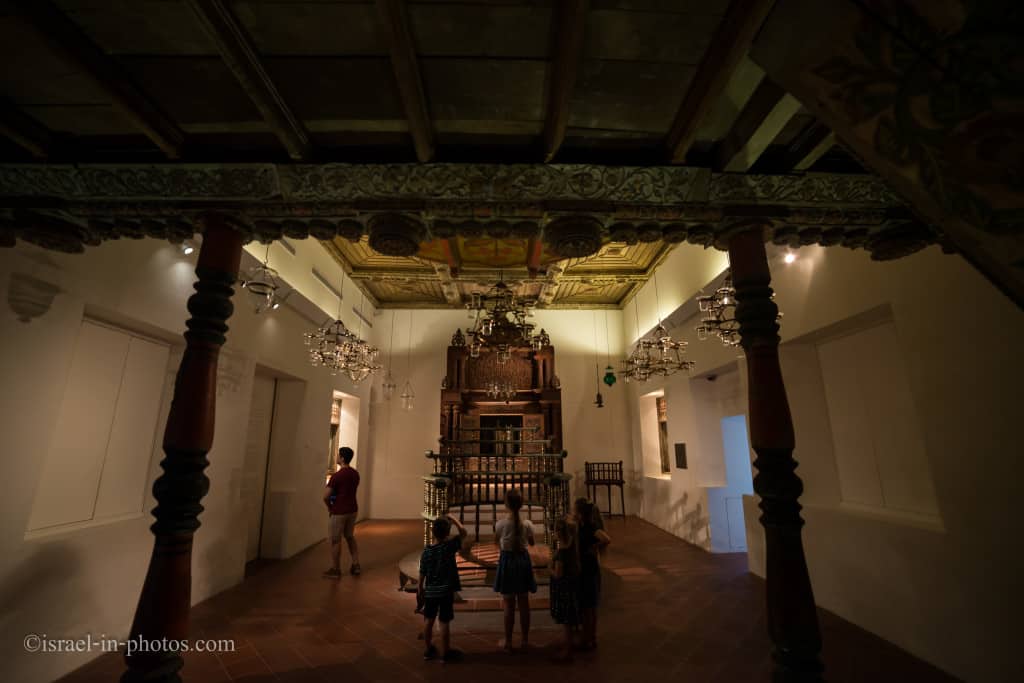
From the 16th century, the Kadavumbagam (“by the side of the landing place“) synagogue stood at the edge of the Jewish neighborhood in the town of Cochin, India, apparently built over the ruins of an even earlier synagogue. Its carved wooden interior came to include a beautiful ceiling featuring motifs like those found in the surrounding mosques and Hindu temples.
According to local tradition, the Jewish community of Cochin is approximately two thousand years old. It started in Cranganore (Shingly) on the southwest coast of India and relocated to Cochin and nearby towns in the 14th century. The Kadavumbagam synagogue, built by the veteran community known as Malabaris, was one of eight temples in this area.
A unique feature of Cochin synagogues is the presence of two reader’s platforms: one, used on Sabbath and holidays, is located on the gallery, in front of the women’s section and separated from it by a grill. Prayers used the other stands in the center of the hall for daily praying. The synagogue was oriented northwest, toward Jerusalem. Wooden benches were ranged around the lower reader’s platform and adjacent to the walls. They covered the floor with carpets or mats on which worshipers walked barefoot.
In the early 1950s, most Cochin Jews immigrated to Israel, and the Kadavumbagam synagogue Torah ark was transferred to Moshav Nehalim. The building, used as a workshop for the production of ropes, was in danger of being demolished. In 1991 synagogue interior was purchased for the Israel Museum and brought to Jerusalem for restoration and reconstruction.
Kadavumbagam Synagogue is unique. First, it is from India, and I had no idea there were ancient synagogues. Secondly, I have never seen the wooden interior of temples.
Synagogue From Suriname
And if we are talking about different temples, then take a look at this one:
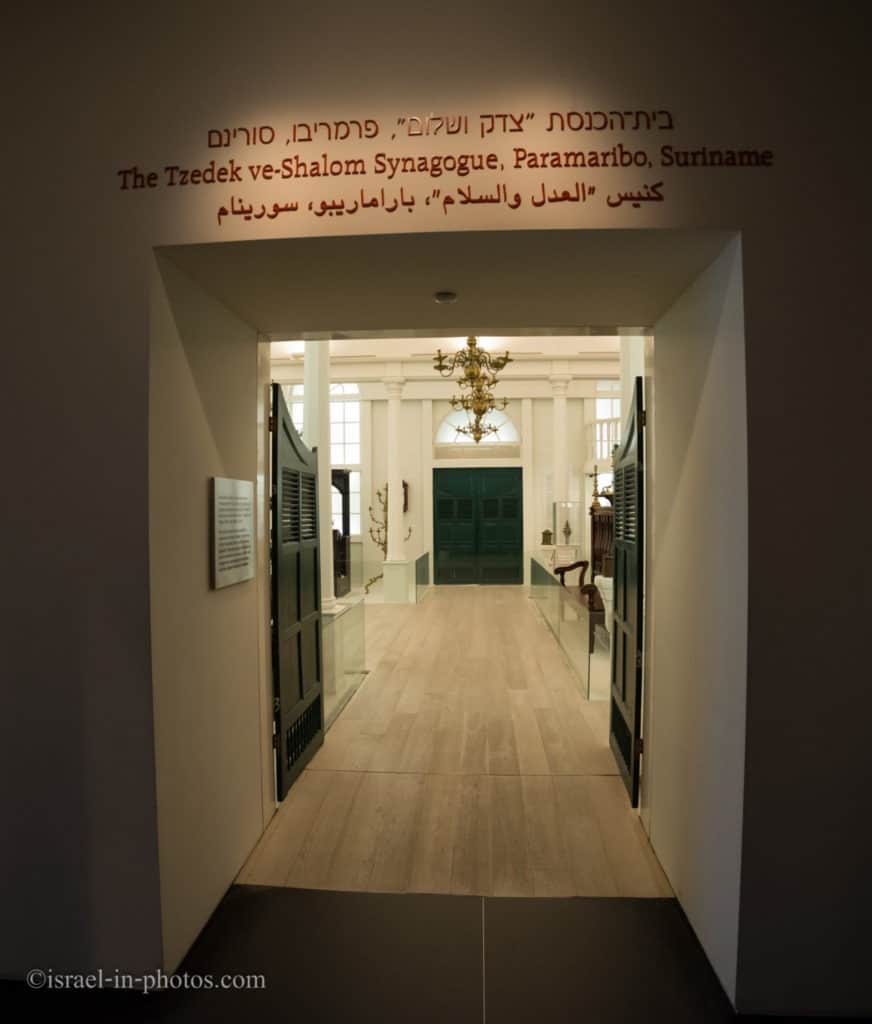
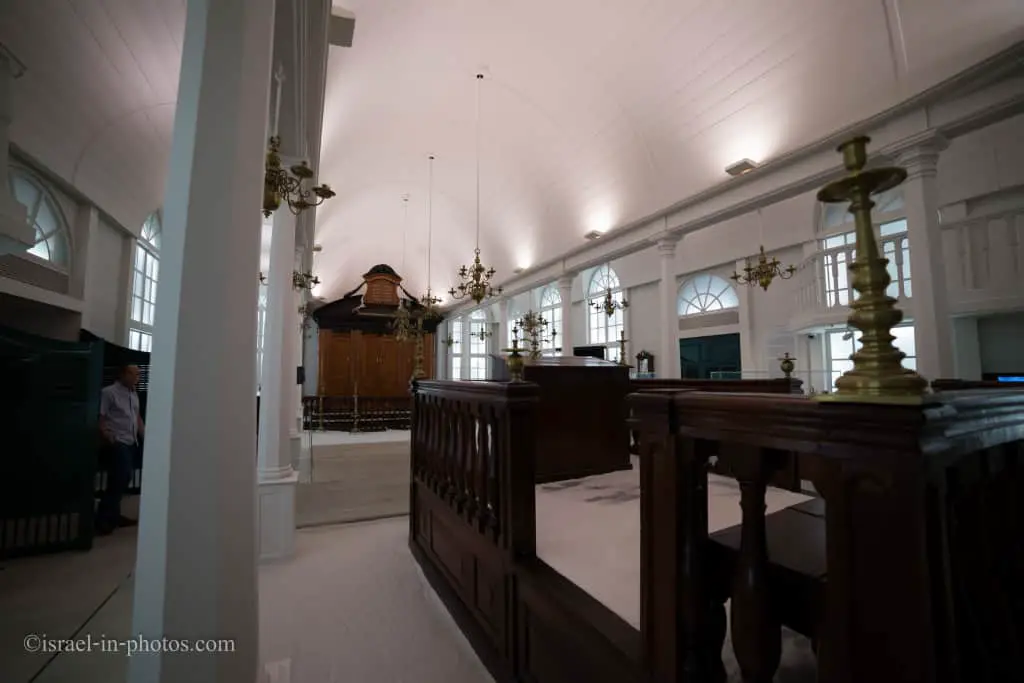
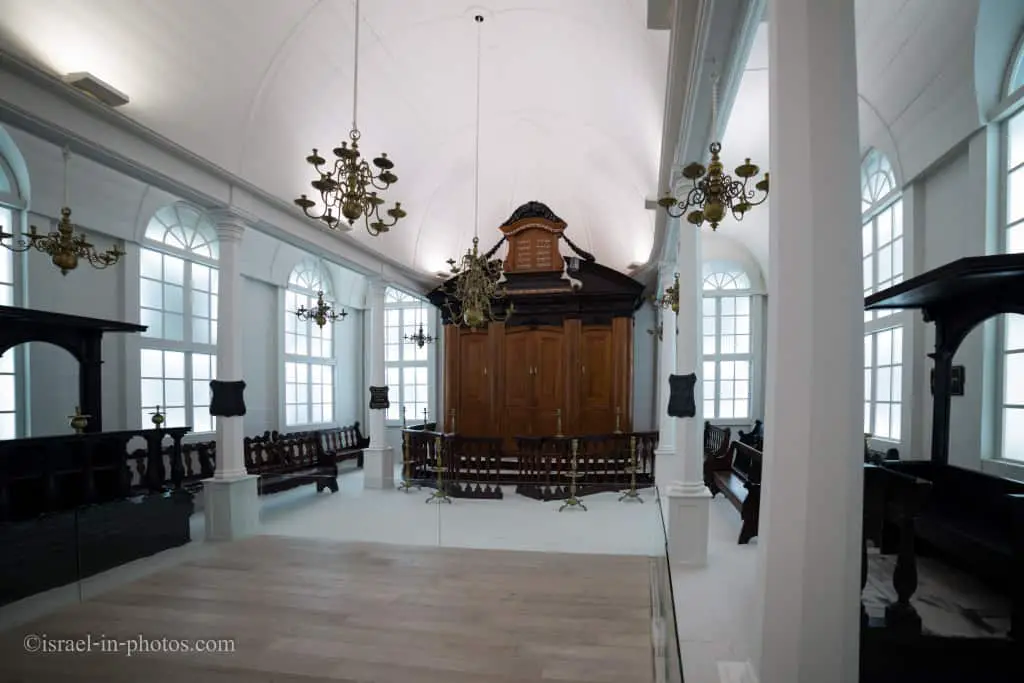
Founded in Paramaribo, the capital city of Suriname, in 1736, the Tzedek ve-Shalom synagogue is a typical example of Spanish and Portuguese synagogues in the New World.
The Republic of Suriname is a tropical country situated on the northern coast of South America, just above Brazil. In the mid-17th century Jews of Spanish and Portuguese origin, who had fled to Holland during the Inquisition, were among the early European settlers in Suriname. They established sugarcane plantations along the Suriname River, to which they gave biblical names, and founded a village in the Savanna, which they called “Jerusalem on the Riverside.” Also referred to as the Jewish Savanna, it became the center of this remote colony until the middle of the 18th century, when most of the Jews moved to Paramaribo.
Synagogue’s Architecture
Formerly situated in the middle of a large courtyard, the Tzedek ve-Shalom synagogue is a neoclassical wooden building, rectangular and painted white. Flanked by three arched windows, the central entrance leads to a vast basilica-like hall whose salient features are typical of the Spanish and Portuguese tradition. The reader’s platform (tevah) is located opposite the Torah ark (heikhal). The benches for the congregants run along the walls, facing the center, and among them are more prominent seats dedicated to the leaders of the community (parnassim) and the head of the community. And grand brass chandeliers of Dutch manufacture, inscribed with the names of the donors who offered them to the synagogue, hang from the ceiling and between the colonnades.
Allied with these features are others which are characteristic of the local, regional architecture, such as the bright, symmetrical structure; the white walls and large windows that invite the sunlight; and the sand-coated floor.
Directly inspired by the Esnoga, the great Portuguese synagogue of Amsterdam, the Tzedek ve-Shalom synagogue reverberates with old memories while embodying original architectural features. It is a clear reflection of the character of the Jewish community of Suriname – a community that enjoyed relative freedom of worship and took an active part in the life of the surrounding society.
Yep, Suriname. The interior is made of white wood, and the floor (only those parts where people don’t walk) is covered with sand (as it initially was).
Jewish Artifacts
Jewish artifacts from different parts of the world:
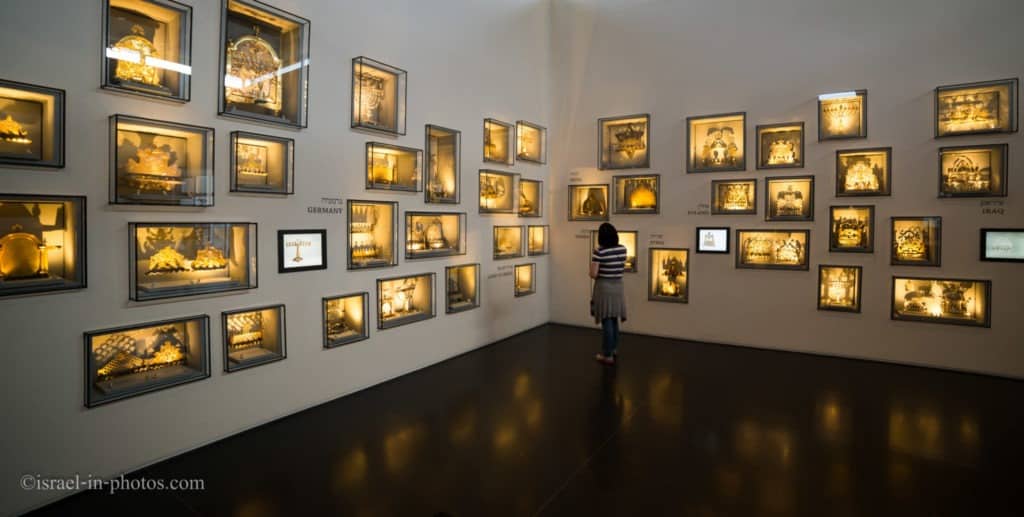
Here is dual-functioning jewelry. The apparent function is beauty and status. However, the less obvious is what materials were incorporated into this necklace. When touching the skin, this necklace gave off a strong fragrance (believed to ward off evil spirits).

Fine Arts
Then, we headed to the Fine Arts wing. But it was already quite late, so we did not adequately cover it. Here are several photos:
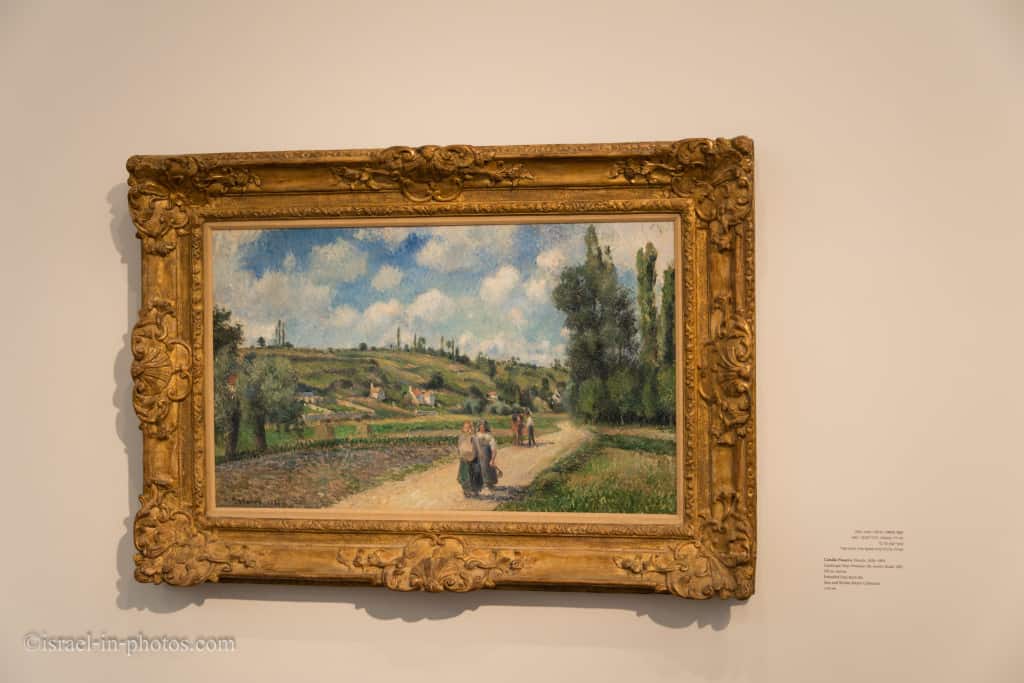
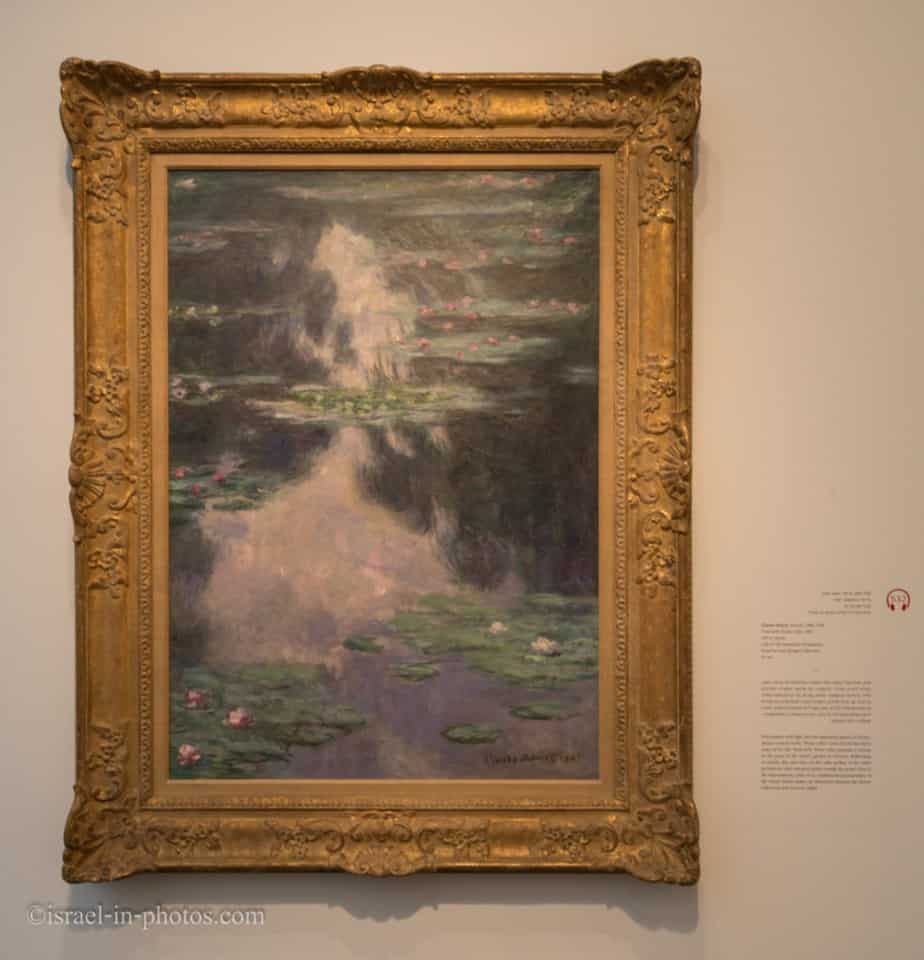
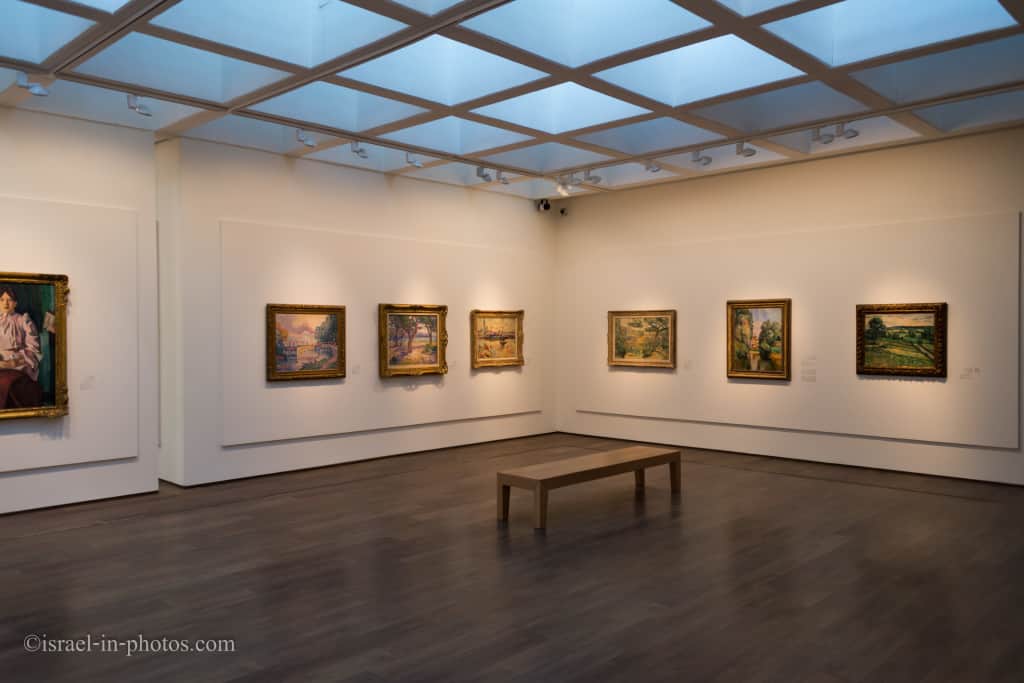


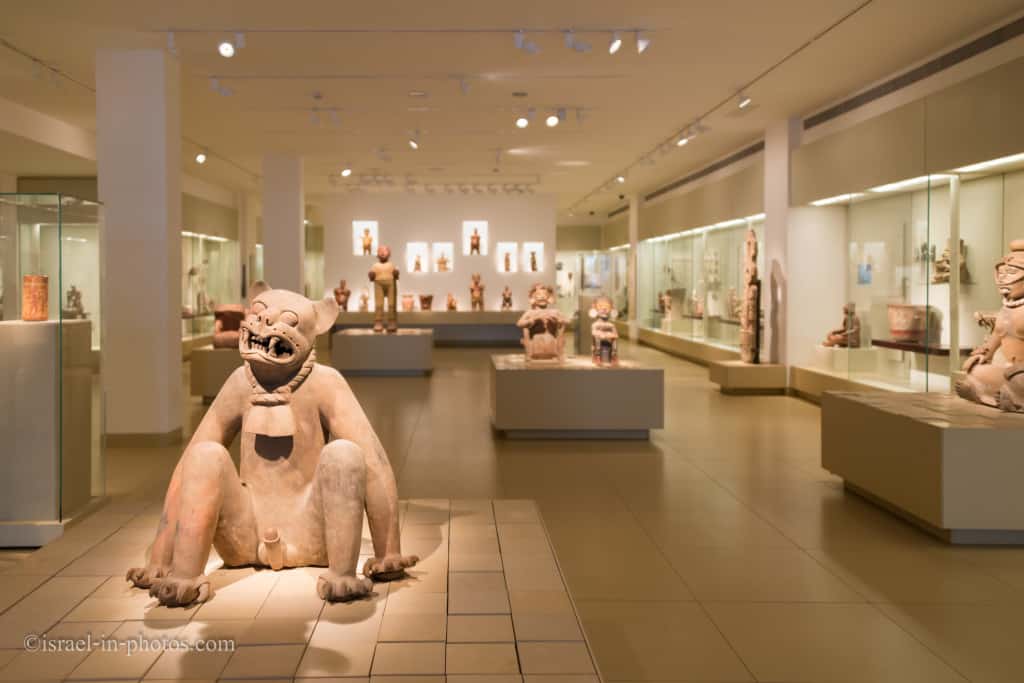
We exited the museum’s building and headed toward the Shrine of the Book. In the statues garden, you can find different statues.
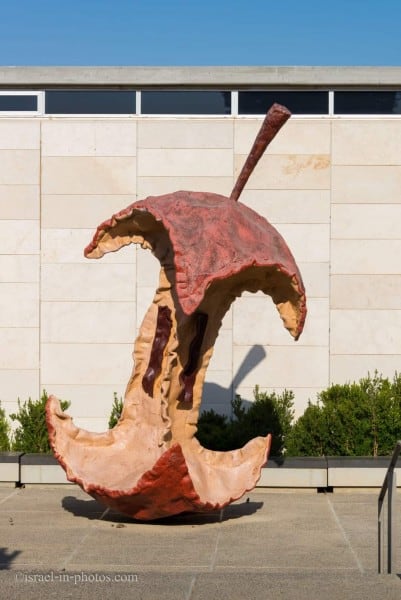
The Dead Sea Scrolls
Before entering the Shrine Of The Book, I want to mention the Dead Sea Scrolls. And that is because the Shrine Of The Book was constructed to house those scrolls.
The Dead Sea Scrolls are ancient manuscripts that were discovered between 1947 and 1956 in eleven caves near Khirbet Qumran, on the northwestern shores of the Dead Sea.
They are approximately two thousand years old, dating from the third century BCE to the first century CE. Most of the scrolls were written in Hebrew, with a smaller number in Aramaic or Greek. Most of them were written on parchment, except a few written on papyrus. The vast majority of the scrolls survived as fragments – only a handful were found intact. Nevertheless, scholars have managed to reconstruct from these fragments approximately 950 different manuscripts of various lengths.
The manuscripts fall into three major categories: biblical, apocryphal, and sectarian. The biblical manuscripts comprise some two hundred copies of books of the Hebrew Bible, representing the earliest evidence for the biblical text in the world. Among the apocryphal papers (works that were not included in the Jewish biblical canon) are works that had previously been known only in translation, or that had not been known at all. The sectarian manuscripts reflect a wide variety of literary genres: biblical commentary, religious-legal writings, liturgical texts, and apocalyptic compositions. Most scholars believe that the scrolls formed the library of the sect that lived at Qumran. However, it appears that the members of this sect wrote only part of the manuscripts themselves, the remainder having been composed or copied elsewhere.
The discovery of the Dead Sea Scrolls represents a turning point in the study of the history of the Jewish people in ancient times, for never before has a literary treasure of such magnitude come to light. Thanks to these remarkable finds, our knowledge of Jewish society in the Land of Israel during the Hellenistic and Roman periods as well as the origins of rabbinical Judaism and early Christianity has been greatly enriched.
Shrine Of The Book
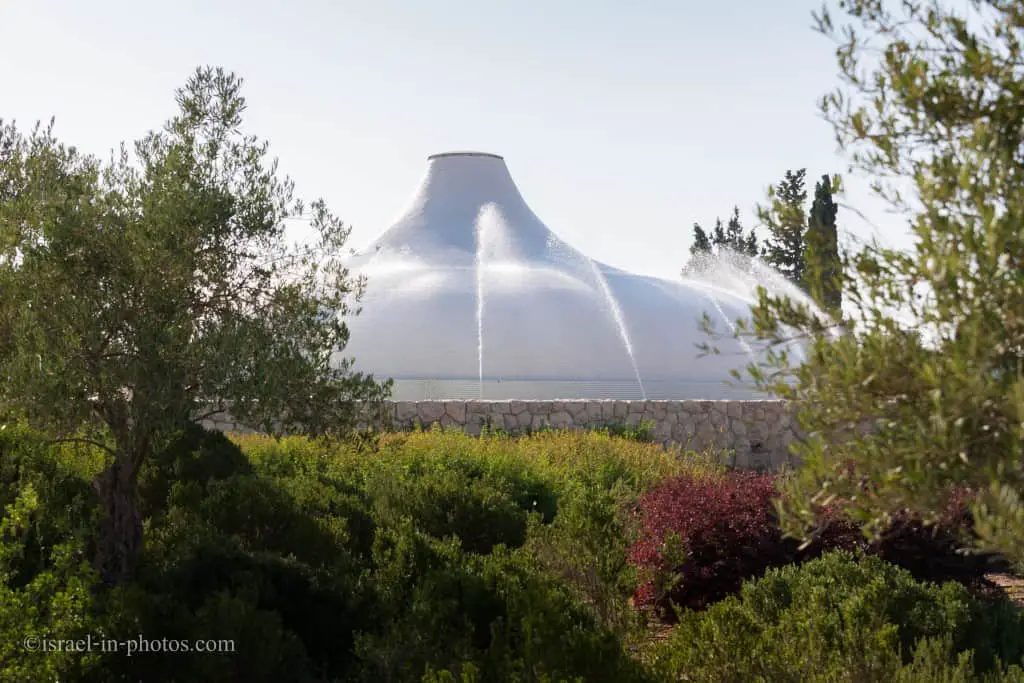
The Shrine of the Book was built as a repository for the first seven scrolls discovered at Qumran in 1947. The unique white dome embodies the lids of the jars in which the first scrolls were found. This symbolic building, a kind of sanctuary intended to express profound spiritual meaning, is considered an international landmark of modern architecture. Designed by American Jewish architects Armand P. Bartos and Frederic J. Kiesler, it was dedicated in an impressive ceremony on April 20, 1965.
Its location next to official institutions of the State of Israel—the Knesset (Israeli Parliament), principal government offices, and the Jewish National and University Library—is appropriate considering the degree of national importance that has been accorded the ancient texts and the building that preserves them.
The contrast between the white dome and the black wall alongside it alludes to the tension evident in the scrolls between the spiritual world of the “Sons of Light” (as the Judean Desert sectarians called themselves) and the “Sons of Darkness” (the sect’s enemies). The corridor leading into the Shrine resembles a cave, recalling the site where the ancient manuscripts were discovered.
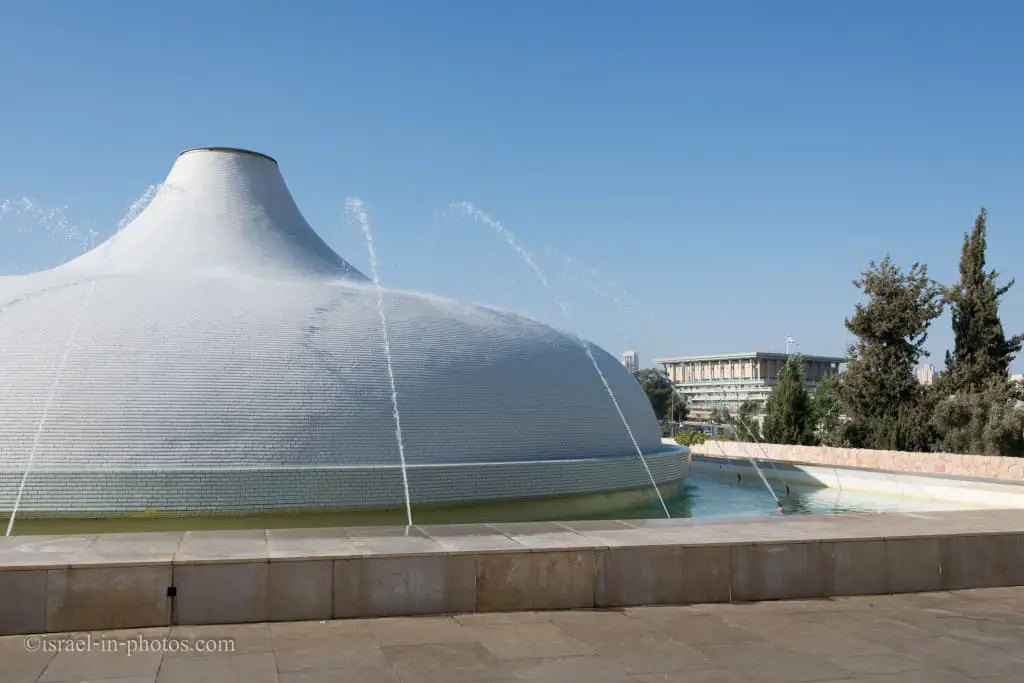
Did you know that you can tour the Knesset? For additional info, check out Knesset – The Parliament Tours.
You could see the original scrolls when the Shrine of the Book opened. But, since the manuscripts can be damaged by light and humidity, they were stored safely. Today, you can see only one original page (and every once in a while, they change which page you can see), and all the rest are replicas.
Besides the scrolls, there are many related exhibits. You can easily spend an hour inside.
Note: photography inside the Shrine of the Book is prohibited.
NANO Bible
We saw the NANO Bible temporary exhibition when we exited the Shrine of the Book.
On the occasion of the Museum’s 50th anniversary, a new exhibition space in the Shrine of the Book is inaugurated with this display of a cutting-edge version of the Bible – a gilt nano chip the size of a sugar grain, on which the entire Bible is inscribed. Illustrating the power of nanotechnology, this high-tech miracle was created in the laboratories of Haifa’s Technion Institute using a technique recalling stone engraving. The text engraved on the chip needs to be magnified 10,000 times to be legible. The exhibition takes the Book of Books on a journey from antiquity to the present – from the 2,000-year-old Dead Sea Scrolls to the 21st-century Nano Bible.
This is the small nanochip containing the Bible (the little spot in the center of the lower glass column):
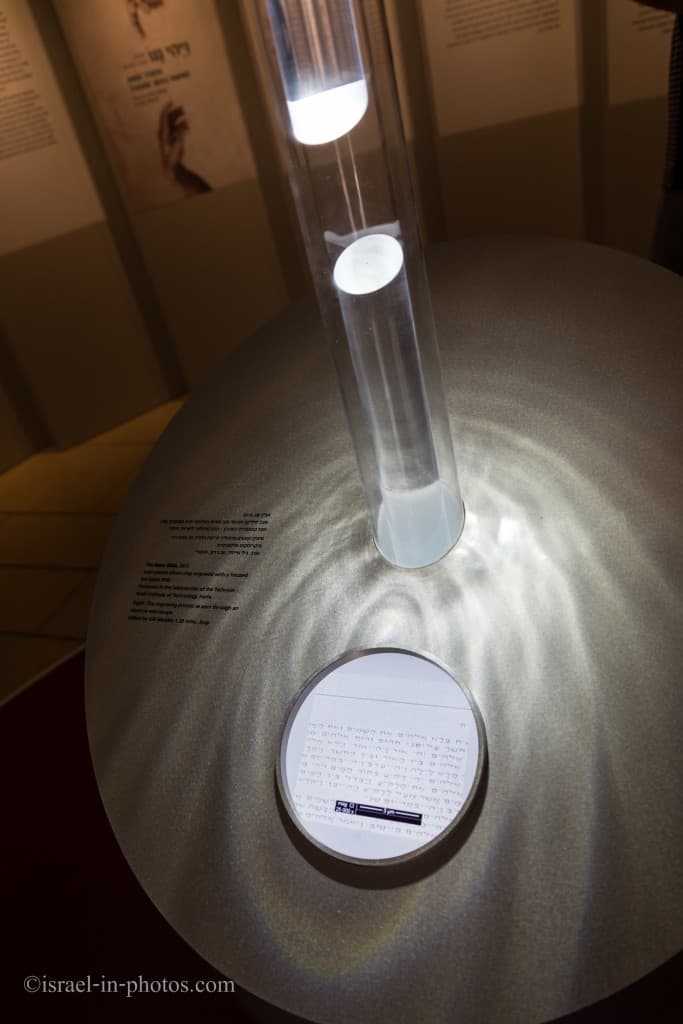
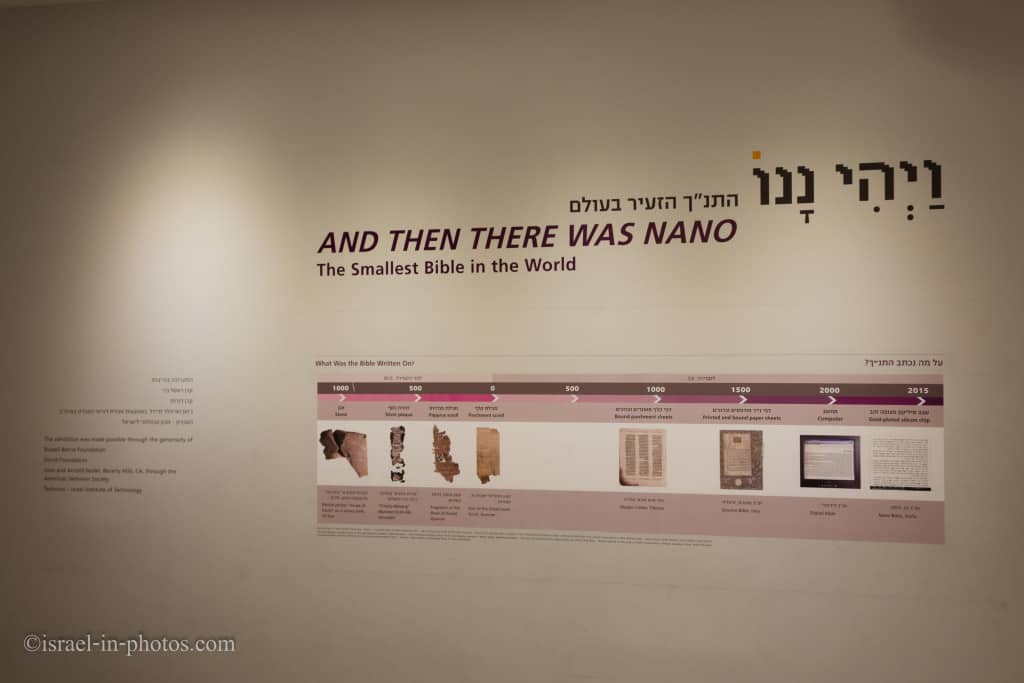
Second Temple Model
Behind the Shrine of the Book, you can find the Second Temple Model.

This 50:1 scale model, covering nearly one acre, evokes ancient Jerusalem at its peak, meticulously recreating its topography and architectural character in 66 CE, the year in which the Great Revolt against the Romans broke out, leading to the destruction of the Temple and the city in the year 70 CE.
The model, a Jerusalem cultural landmark, was originally built at the initiative of Holyland Hotel owner Hans Kroch in memory of his son Jacob, who fell in Israel’s War of Independence. Kroch argued that Israel in general, and in particular its capital Jerusalem – which was cut off from the Old City at the time – lacked a historical monument that could compare with the antiquities of Athens and Rome.

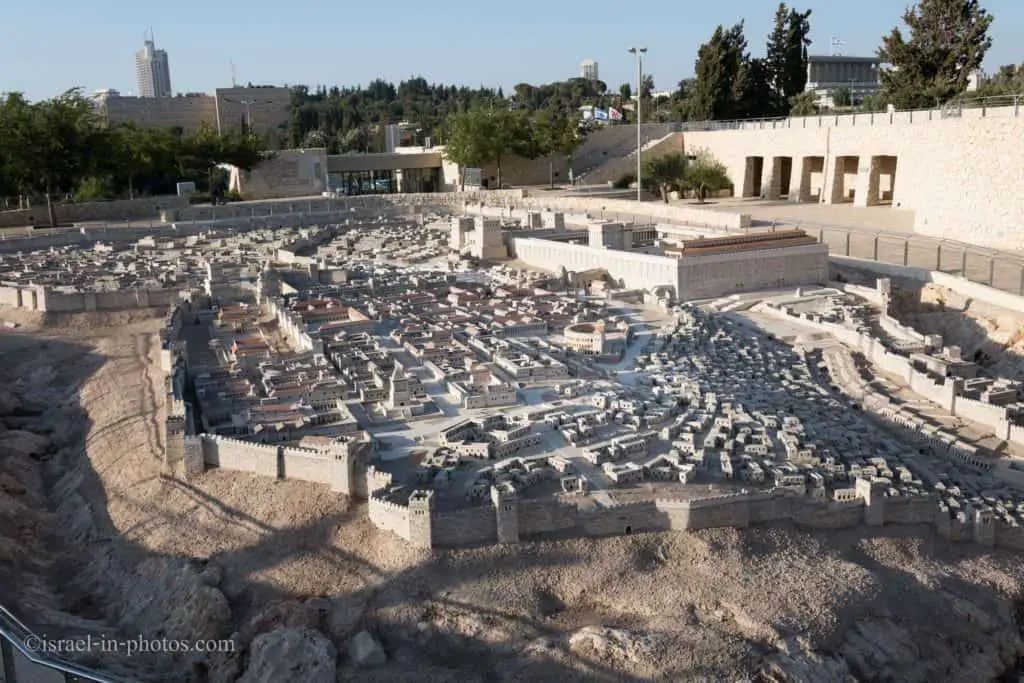
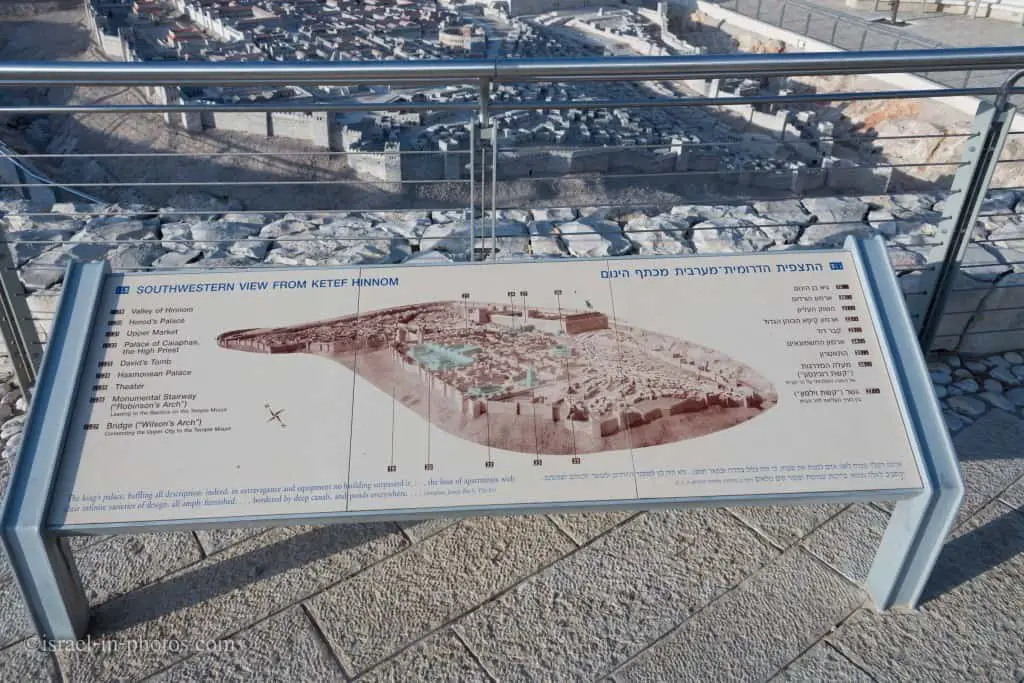
That was our final point of interest inside the Israel Museum, and we went toward the exit. We visited the souvenir shop next to the exit, and I saw Zion’s Action Figures inside.
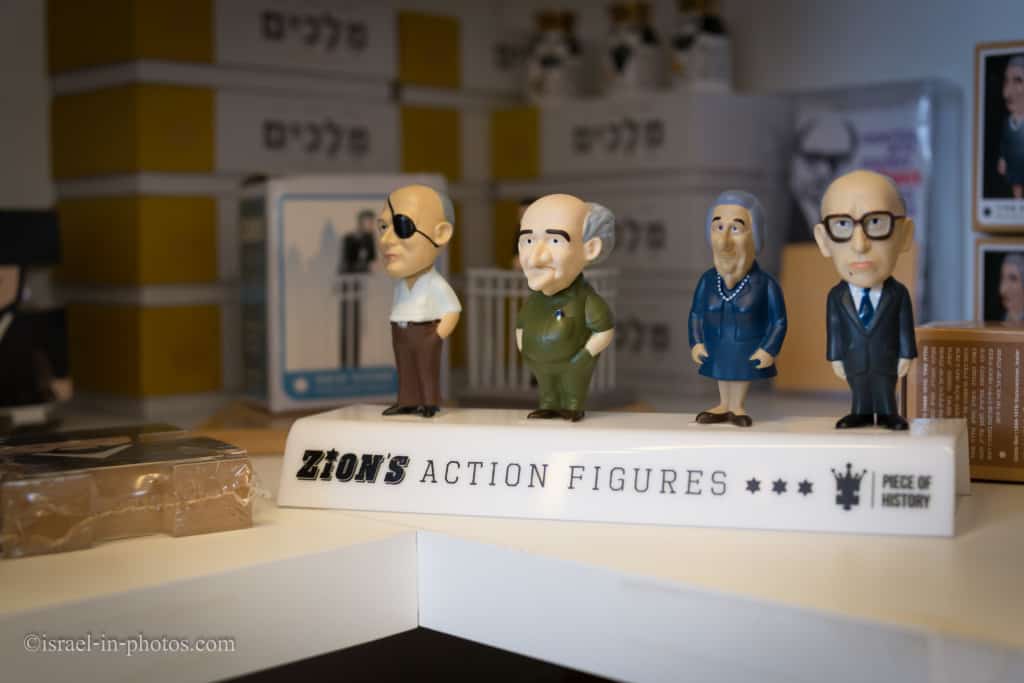
Israel Museum – Basic Info
The Israel Museum was established in 1965 as Israel’s national museum. It is situated on a hill in Jerusalem’s Givat Ram neighborhood, adjacent to the Bible Lands Museum, the Knesset, the Israeli Supreme Court, and the Hebrew University of Jerusalem.
Among the unique objects on display are the Venus of Berekhat Ram, the interior of a 1736 Zedek ve-Shalom synagogue from Suriname; necklaces worn by Jewish brides in Yemen; a mosaic Islamic prayer niche from 17th-century Persia; and a nail attesting to the practice of crucifixion in Jesus’ time. An urn-shaped building on the grounds of the museum, the Shrine of the Book, houses the Dead Sea Scrolls and artifacts discovered at Masada. It is one of the largest museums in the region.
Source: Wikipedia
Old City Of Jerusalem At Night
Next, we headed toward the Old City for a short walk. However, since I have a dedicated post to the Old City Of Jerusalem, I will only show several photos in this post.
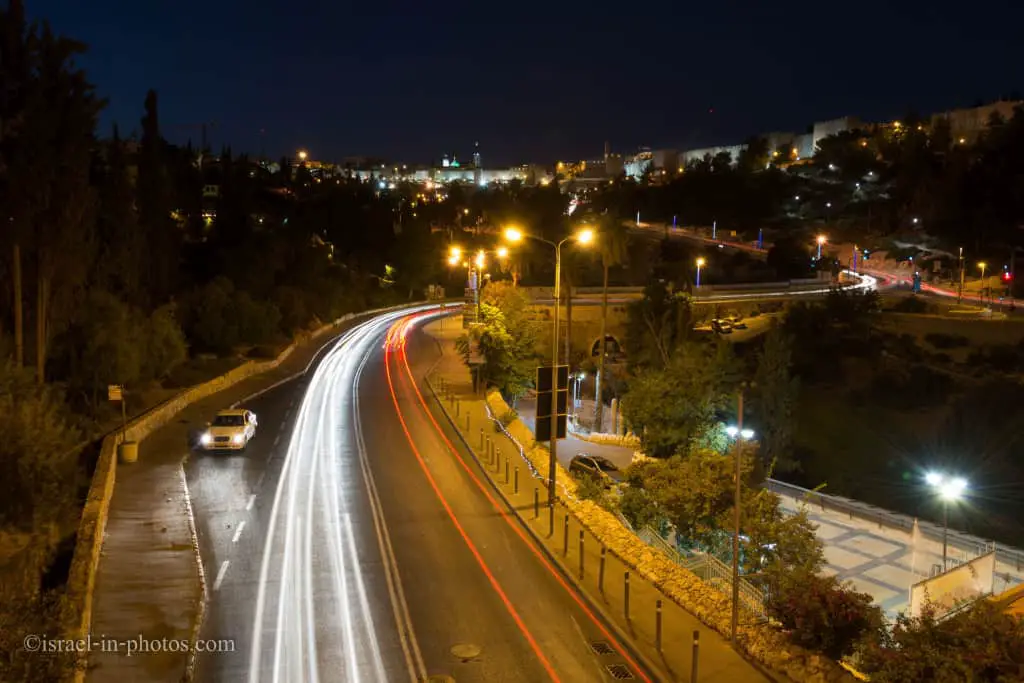

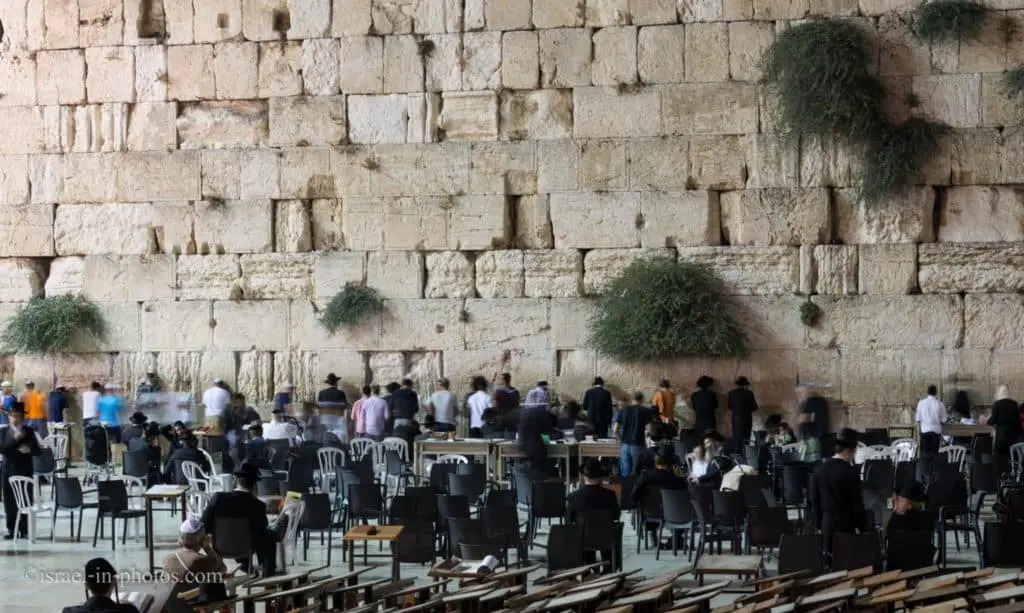

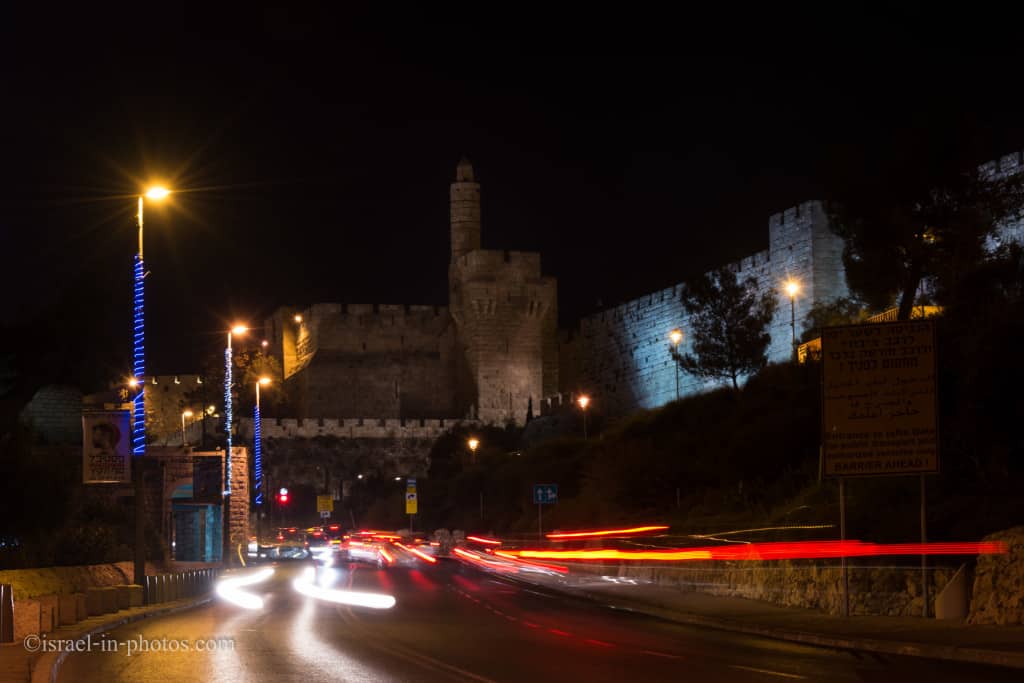
It is late, and it is time to end the day.
Common Questions
Israel Museum and many other popular museums in Jerusalem, like the Bloomfield Science Museum, are open on Shabbat. Its opening hours on Saturday are 10:00 – 16:00.
The Dead Sea Scrolls are inside the Shrine Of The Book in the Israel Museum complex. And if you want to learn more about the scrolls, you should visit them. But keep in mind that you will see only one original page.
The scrolls are approximately two thousand years old, dating from the third century BCE to the first century CE.
Israel Museum is quite big, and a typical visit will take a half-day to a full day, depending on the areas you visit. And if we use big data, Google says, “People typically spend up to 3 hours here.”
Summary
The Israel Museum in Jerusalem is one of the best and biggest museums in Israel. If you visit only one museum in Israel, this should probably be it. If you are interested in archeology, ancient findings, or Judaism, this should be it.
The duration of your visit will depend on your interests and what temporary exhibitions are on display (check the official site to see current exhibitions). But, in general, most people will spend several hours to a full day.
Have you ever visited the Israel Museum in Jerusalem? Tell us about your experience in the comments below.
That’s all for today, and I’ll see you in future travels!
Stay Tuned!
For additional points of interest nearby, check out Jerusalem.
Additional Resources
Here are several resources that I created to help travelers:- Trip Planner with Attractions and Itineraries is the page that will help you create your perfect travel route.
- What is the Best Time to visit Israel? To answer this question, we will consider the weather, prices, holidays, festivals, and more.
- Information and Tips for Tourists to Israel will answer the most common questions tourists have about Israel (including safety, passports, weather, currency, tipping, electricity, and much more).
- Israel National Parks and Nature Reserves include a complete list, top ten, map, tickets (Israel Pass, Matmon, combo), and campsites.
- If you are looking for things to do, here are the pages for Jerusalem, Tel Aviv, Haifa, Sea Of Galilee, Akko (Acre), Eilat, Nazareth, Safed (Tzfat), and Makhtesh Ramon.


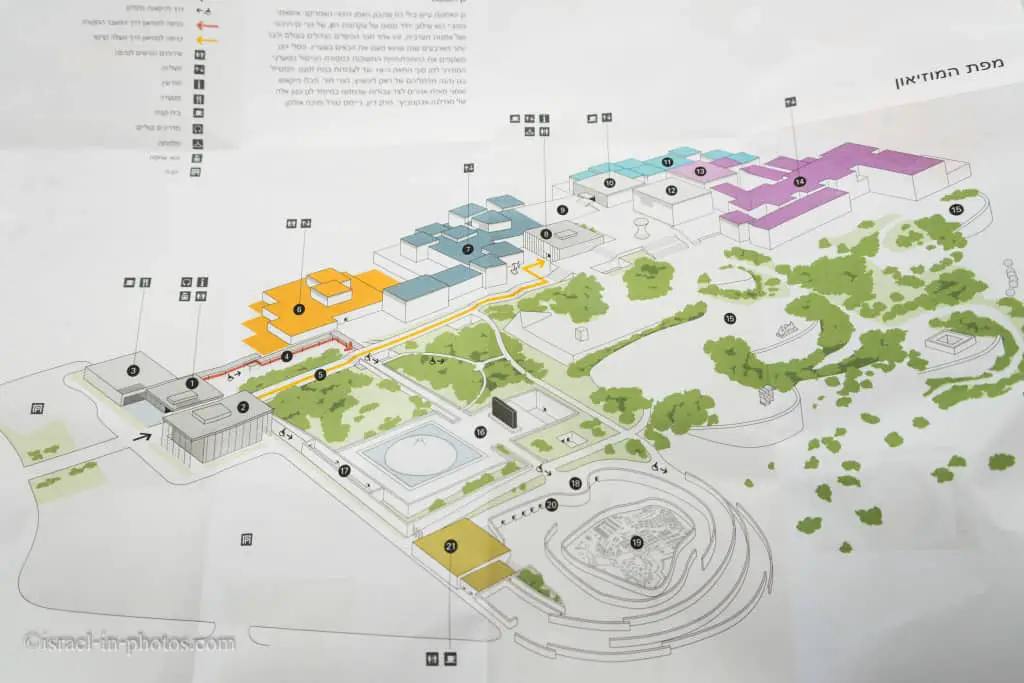



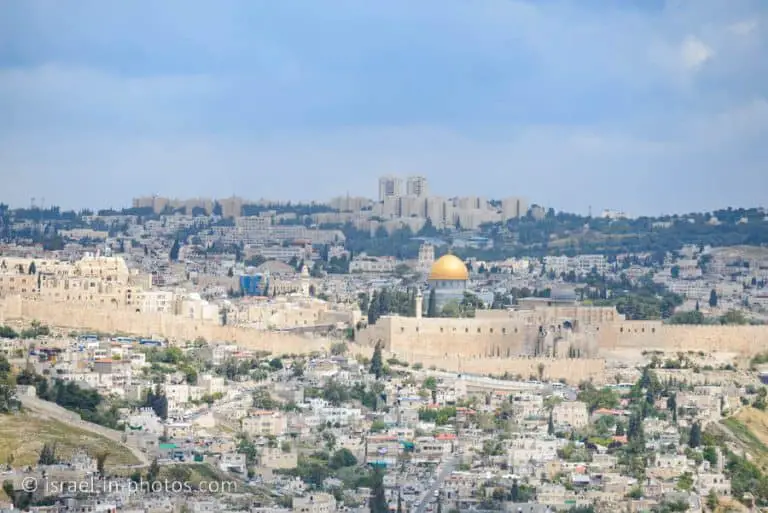


If the Most High YHVH permits, i plan to go to the holy land of Israel to explore all its places including Mount Sinay where Moses had gone up. Here are my questions if you won’t mind: Is Mt. Sinay part of Egypt or Israel? The Golan Heights located in Samaria was part of Israel, how did it become under the rule of the Jordan government? Can the Israeli government guarantee the safe and security of its foreign visitors/tourists as Israel being surrounded by these trouble-makers Hamas, Houthis, Hizbollah, Isis, etc. I wonder why Imam or Muslim preachers claimed that their religion named ISLAM was derived from Arabic “salam” meaning “peace,” and yet, some of its Muslim Sunnis and Shiites proxies terrorists ‘hated’ the Jews by strongly shouting: “Death to the Jews! Death to the Americans!” (Prov.17:15). Where is then the ‘peace or love’ the Imam talking about? For me, faith without good works is dead!
Hi Danilo,
– As far as I know, nobody knows exact location of Mount Sinai. Most people think it is near Saint Catherine’s Monastery in Egypt.
– Golan Heights and Samaria are two different regions. Samaria was given to the Arabs as part of 1948 partition plan. And remained under Jordanian rule after the war of independence.
– Inside Israel the situation is safe. We don’t have anymore rockets from Gaza, Lebanon and Iran. The only remaining threat is the Houthis. They usually fire a ballistic rocket once a week and we go into shelters. If you are in a city, there should be no problem. There are many shelters and you just follow the locals. I would suggest installing “Home Front Command” app on your phone, to receive notifications.
– The mentioned saying is a PR move. It will be said only in English, while Arabic the message will be completely different. Call me biased, but it is similar to Palestinian propaganda – 90% of it is lies.